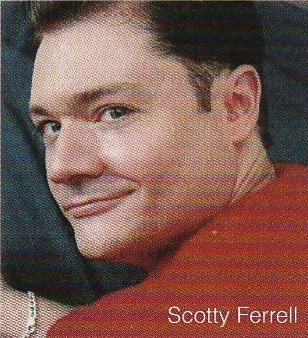 I'm always so grateful when someone agrees to an interview with the Museum, and the one I'm featuring today is very special! You might remember the AstroLips lipstick line that was mentioned in the Museum's history of zodiac-themed makeup and how I was puzzled over not being able to find any information about it or its creator, makeup artist Scotty Ferrell. Well, as luck would have it, Scotty found the Museum's article and introduced himself and offered more information on the line. Naturally I wanted to hear as much as possible about it, along with Scotty himself! He kindly granted me an interview. Please read on to discover his work, his experience working with some of the biggest brands in the '90s and early 2000s, and his latest venture: an (actually useful!) beauty app.
I'm always so grateful when someone agrees to an interview with the Museum, and the one I'm featuring today is very special! You might remember the AstroLips lipstick line that was mentioned in the Museum's history of zodiac-themed makeup and how I was puzzled over not being able to find any information about it or its creator, makeup artist Scotty Ferrell. Well, as luck would have it, Scotty found the Museum's article and introduced himself and offered more information on the line. Naturally I wanted to hear as much as possible about it, along with Scotty himself! He kindly granted me an interview. Please read on to discover his work, his experience working with some of the biggest brands in the '90s and early 2000s, and his latest venture: an (actually useful!) beauty app.
MM: How did you get into makeup? What interested you about it?
SF: My fascination for cosmetics began when I got into trouble playing in my Mom’s makeup and opening all the small perfume bottles she had from Avon. I would get so excited when the Avon lady came over to visit and brought her big case of colors and potions. I was hooked. The mystery of all the pretty colors and glass containers captured my spirit.
MM: What was your experience working in makeup in the '90s? And what were the big trends/products?
SF: The 1990’s really were amazing years for makeup. People were so excited to sit and learn about their makeup wanting to know how to apply eyeliner themselves and experiment with color. Quality makeup brushes and how to use them was so rewarding to work with people ready to discover and develop their own personal style. I had so much fun painting faces because the trends were really strong and each seasonal look was trying to top the next. I think the light lid and strong crease was all the rage because finally single eyeshadows were available in the artistry brands allowing for more experimentation. I loved when I started applying to my clients two different color liners top and bottom lash lines. Jewel tones in combination were really big during late 90’s.
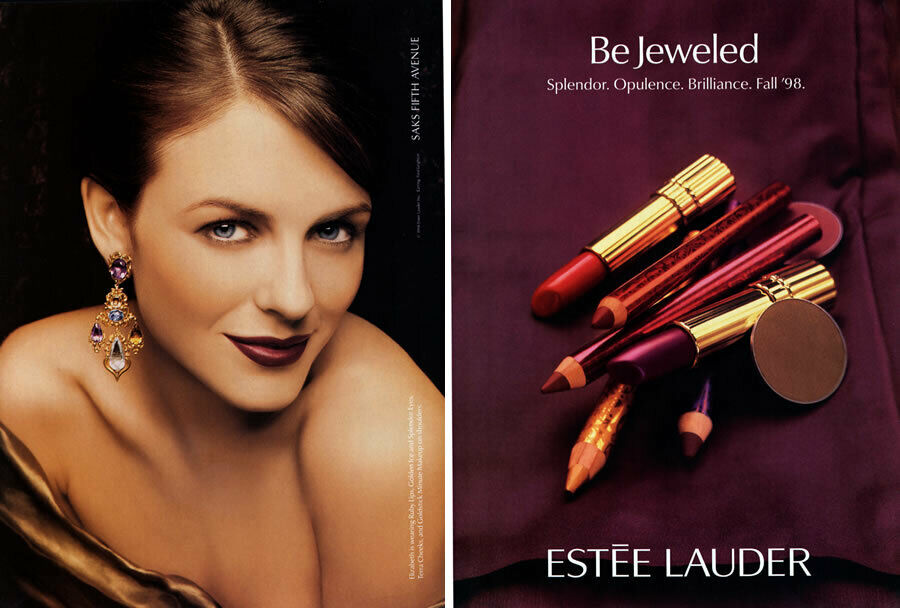
The true smokey eye also came from this time period. The smokey eye really is buffing out the eyeliner on the lower lid and layering it with a dark shadow. But now today, anyone wearing eyeshadow says it’s a smokey eye when it’s not. I am not a big fan of the influencers because too much misinformation and lack of experience working with real people seems to be most popular. Influencers are pushing wrong information because they lack the makeup artistry experience applying makeup on people other than themselves. Too many influencers are promoting low quality products and wiz-bang techniques that do not wear or look professional. The legacy brands still have the some of the best tried and true products like Lancome’s Effacernes and Aquatique eye concealer/base, Elizabeth Arden Flawless finish cream foundation these products cannot be beat. Influencers are pushing the industry against quality products that cannot withstand a real photoshoots, catwalks under hot lights or outdoor weddings.
MM: Tell us about your alter ego, Gigi Romero, and how she inspired you to create the AstroLips line!
SF: Say GiGi Romero to me and I light up and am romanced dreaming about the silver screen stars like Bette Davis, Ava Gardner, Sophia Loren just to name a few. GiGi Romero is my muse/ alter ego that channels the larger than life confidence and on-stage personality that celebrates their fans with great entertainment. Makeup delivers the fantasy to a tangible reality, a way to feel special because it’s fun to play dress-up. So when the brainstorm came over me about AstroLips with Lovespell, I thought of GiGi Romero conjuring up the colors and speaking directly with the cosmos to create the shades and stories
belonging to each sun sign. AstroLips with Lovespell may still have a come back yet when GiGi Romero connects with the stars once again!
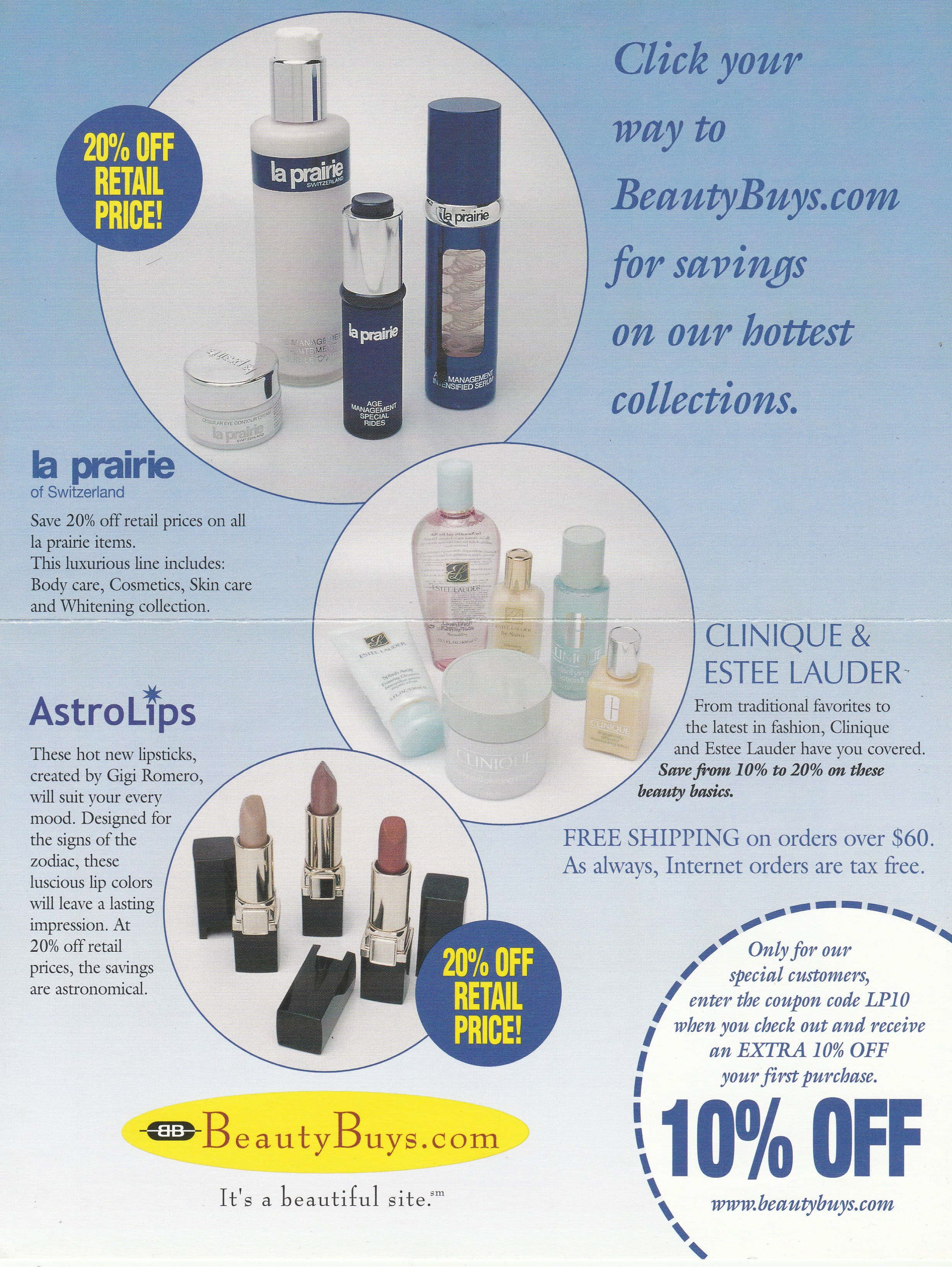
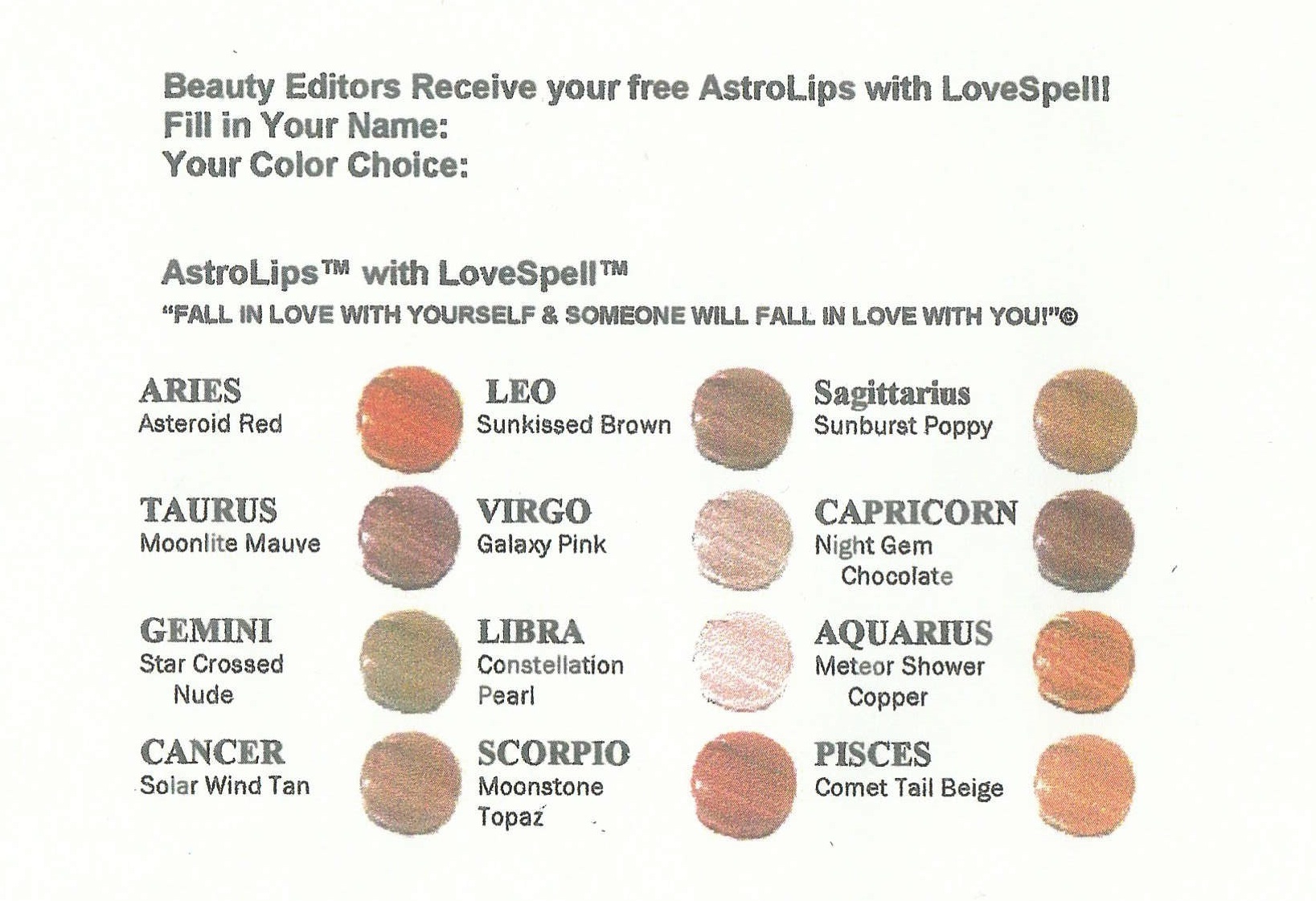
AstroLips shades, 2000. Images provided by Scotty Ferrell.
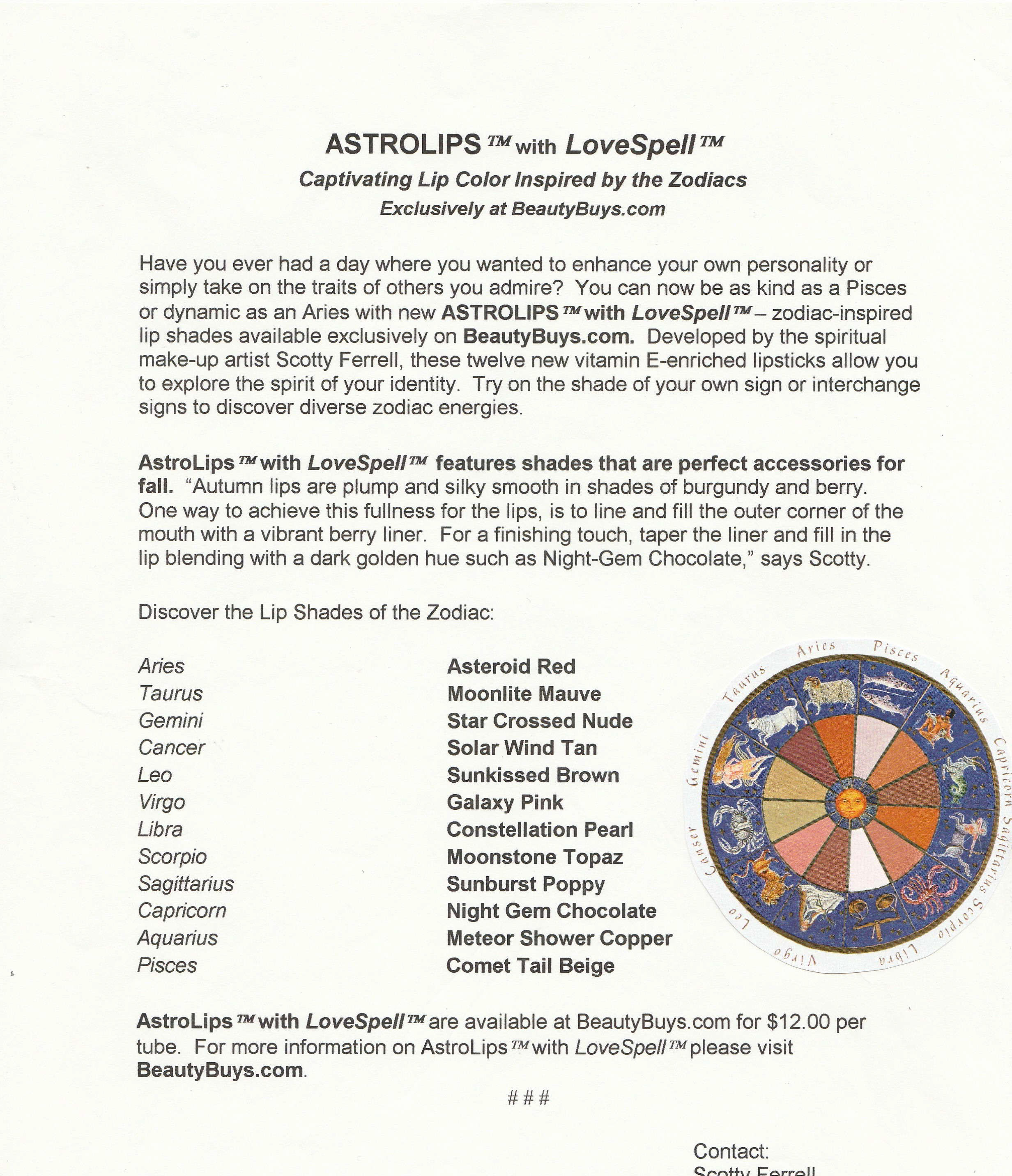
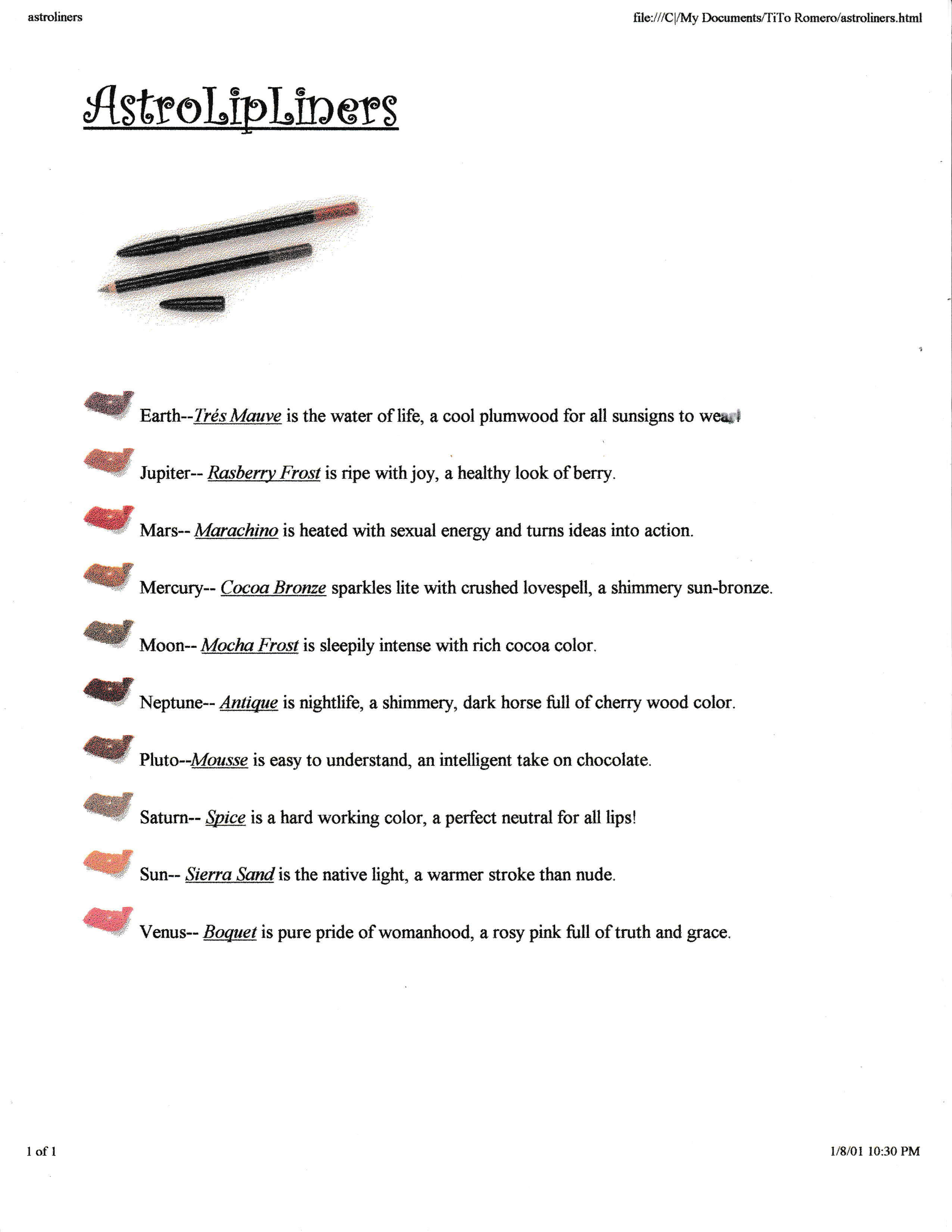
AstroLipLiners, 2001. Image provided by Scotty Ferrell.
MM: You had mentioned [in a previous correspondence] you had some stories about Smashbox, Trish McEvoy planners, etc. Can you expand on those?
SF: Bill Parks, rest his loving soul, does not get the credit he deserves creating the Smashbox brand from scratch let alone me helping him launch the brand coast to coast. I consider the absence of acknowledging his contribution to Smashbox beyond shameful on the part of Estee Lauder and the great grandsons of Max Factor, Dean and Davis. The origin story begins with Bill Parks and me working for Trish McEvoy. Trish McEvoy held a big, big meeting with Nordstrom west coast to bring a next-level strategy for her Nordstrom counters putting Bill Parks in charge and me as at-counter National Artist to produce at the events. After this meeting show casing Bill Parks as a business superstar that he was, Nordstrom secretly invited just Bill to a clandestine behind the curtain meeting for Smashbox. Nordstrom was initially investing in the launch of Smashbox the artistry brand for Dean and Davis Factor, but knew it needed someone who actually understood selling color cosmetics. Bill agreed to their offer and left to be the creative head of Smashbox to create products, sell the products and be the personal face launching the line coast to coast. I stayed with Trish McEvoy for a couple more years seeing Bill grow the brand all on his own.
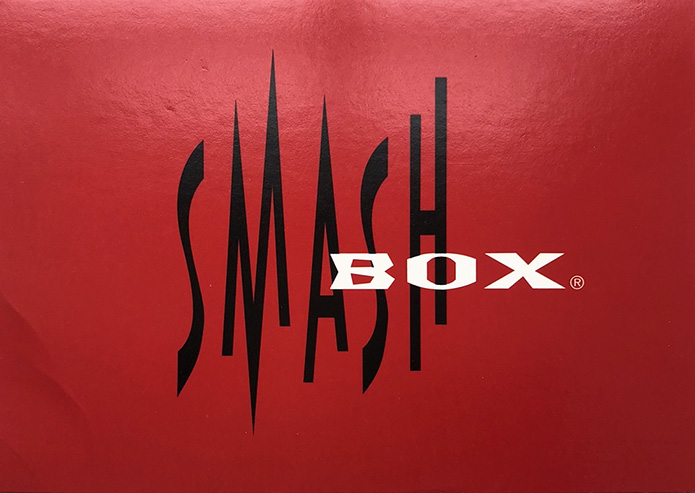
Smashbox postcard, ca. 1996
Bill actually worked to formulate the first cream eyeliner for that time because he knew the pitfalls from Trish’s eyeshadow liners and brush #11. How did Smashbox get on QVC? Well, let me tell you a story. Michael diCesare haircare and hair brushes were in several Nordstrom stores where he also met Bill Parks. They hit it off and whenever I saw Michael he would always ask me where’s Bill? Michael was already on QVC selling his products and asked Bill to do the makeup for his models. The rest is history once QVC met Bill Parks he began selling Smashbox to record heights on their channel. I joined Bill Parks in 1998 launching Smashbox into other retailers in addition to more Nordstrom doors. I trained Holly Mordini who later took Bill’s place on QVC after Bill passed away suddenly. I have many cherished memories and stories about my time with Trish and learning directly from her extremely talented hands and eye for color. Trish gave me the freedom, encouragement and confidence to become the best showman and artist I could be. Trish demanded us to all have a Franklin Planner and follow its system to set goals and exceed them. So after a big, big event in Dallas Neimans Northpark we all piled in this van we thought to go back to the hotel or wherever we were staying that night, but instead Trish had other plans. Somehow she kept telling the driver to continue to drive around, drive around while we all talked and Trish was in the groove to with her vision to send us her elite team back across the country opening counters, raising up important stores that needed an open to buy and who would stay in Dallas making sure we prevented any event returns or sold more than might come back to counter. A bunch of us, her elite team were frantically turning the pages to our Franklin Planners trying to make sure we got every word and detail correct coming from Trish. Suddenly, we all start talking about how organizing our makeup just like our Franklin Planners! I was already putting Face Essential shadows on palette boards to make it easier to paint at events. We all were competing for an edge to sell better and did our best with our brush rolls and our go-to favorites. It was decided that night that Trish had to go to Italy to get this new idea off the ground. The first set of pages were that same kind of plastic used for potted plants you get from the store. The brush bag of course had to be like Trish’s black Chanel bag that I did get to hold for her on one of our trips. The story about how Trish’s Planner came in to existence has changed over the years. Trish tells the story now moving up the timeline to when she was in Italy with her husband ordering the first version. The beginning year of the Planner was very exciting but took a lot of effort before we got better and better versions of the pages which had to be switched out several times for customers.
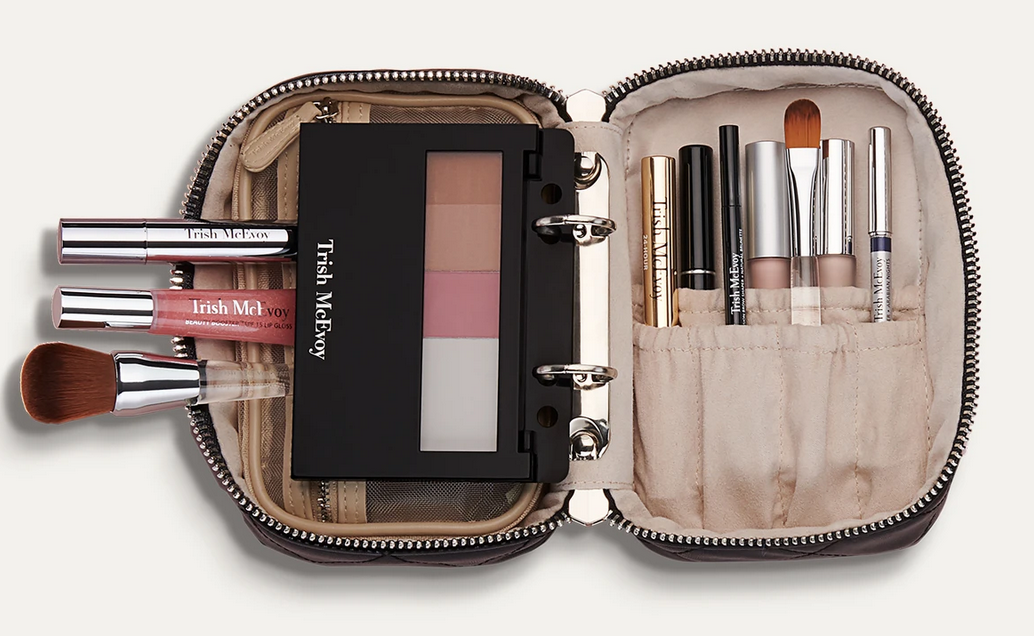
(image from trishmcevoy.com)
There is a very, very important story that I still to this day want to remind Trish personally. I am certain Trish does remember that Saks 5th Avenue almost sabotaged the Planner’s first Christmas. The part that Trish may have forgotten, and I would like to definitely remind her that I am the very person who sounded the alarm. I know exactly where I was and how I found out Saks 5th Ave was ready to go to the floor with their knock-off Planner. I was painting local models for a Saks 5th Ave Fashion show at the Intercontinental Hotel Miami. A Saks 5th Ave big-wig who flew down for the event also came back stage and was showing off what he knew that Saks “had a knock-off Planner in their warehouse ready to go on the Holiday Sales floor to under-cut Trish’s Planner 1 st Christmas.” I ran outside, on my very first cell, all the way outside and called the office demanding to speak with Trish directly. I said it was extremely urgent and that she had better get her lawyers on the phone to save the Planner! I called more than once even on a pay-phone in the lobby with every chance I could get until I was sure the message got through. Trish, if you're listening, my cell number is still the same!
MM: How would you say the cosmetics marketing landscape has changed since the late '90s? (e.g. the impact of the Internet/e-commerce/social media, etc.) And what stayed the same? Do you find it more or less difficult to sell makeup now?
SF: After the 90’s, companies did change dramatically not wanting to support events. Not wanting to pay artists who knew the brand intimately and loved teaching customers how to wear new looks, how to apply their makeup providing live- action customer service. The focus became and still is selling one hit-product at a time. Click-bait selling beauty over the internet breaks down the expertise of professionals that know how to design personalized beauty regimens for individual customers. Brands and social beauty stars are ignoring that beauty products must work together to be successful helping people. It is a must to talk to customers and listen to their needs so their lifestyles fit the products that do work together and deliver the results people are after.
MM: You've explained about your new app, but please elaborate on it and what inspired you to create it.
SF: This is the great segueway to my app. Face My Makeup app is reality based and is a digital version of how millions upon millions of makeup and skincare products were sold for years. Face My Makeup app is a digital face-chart but actually its true potential is personalized beauty’s next generation Face-cart that provides customer service and supports sales. I created Face My Makeup app directly from my experience selling on the road for Trish and BABOR. My customers would carry with them for years and tape to their mirrors the Face-charts I made for them with all the tips, tricks, colors, shades and multiple products that we chose together. Countless times a woman I helped years prior would find me again bringing her Face-chart and wanted a fresh new look. This love for the Face-chart and service it provides is so valuable and necessary for personalized beauty to be meaningful to make sense. Face My Makeup app has been received with open arms having over 5000 downloads from Google Play and the same amounts for iPhone app store. The elevator pitch that grabs people’s attention, “If you lost your makeup bag with all your favs, how many eClicks would it take for you to replace all your makeup? Would you remember all the names, shades and brands? Is there an eCommerce site that knows your Day Look products from your Night Look routine?” eCommerce, Mobile sales are obviously here to stay but what I know is must have companion is the Face-cart service from Face My Makeup app. (Disclaimer: The Makeup Museum is not endorsing/advertising the Face My Makeup app and has not been compensated in any way for mentioning it; its inclusion in this interview is merely for information-sharing purposes.)
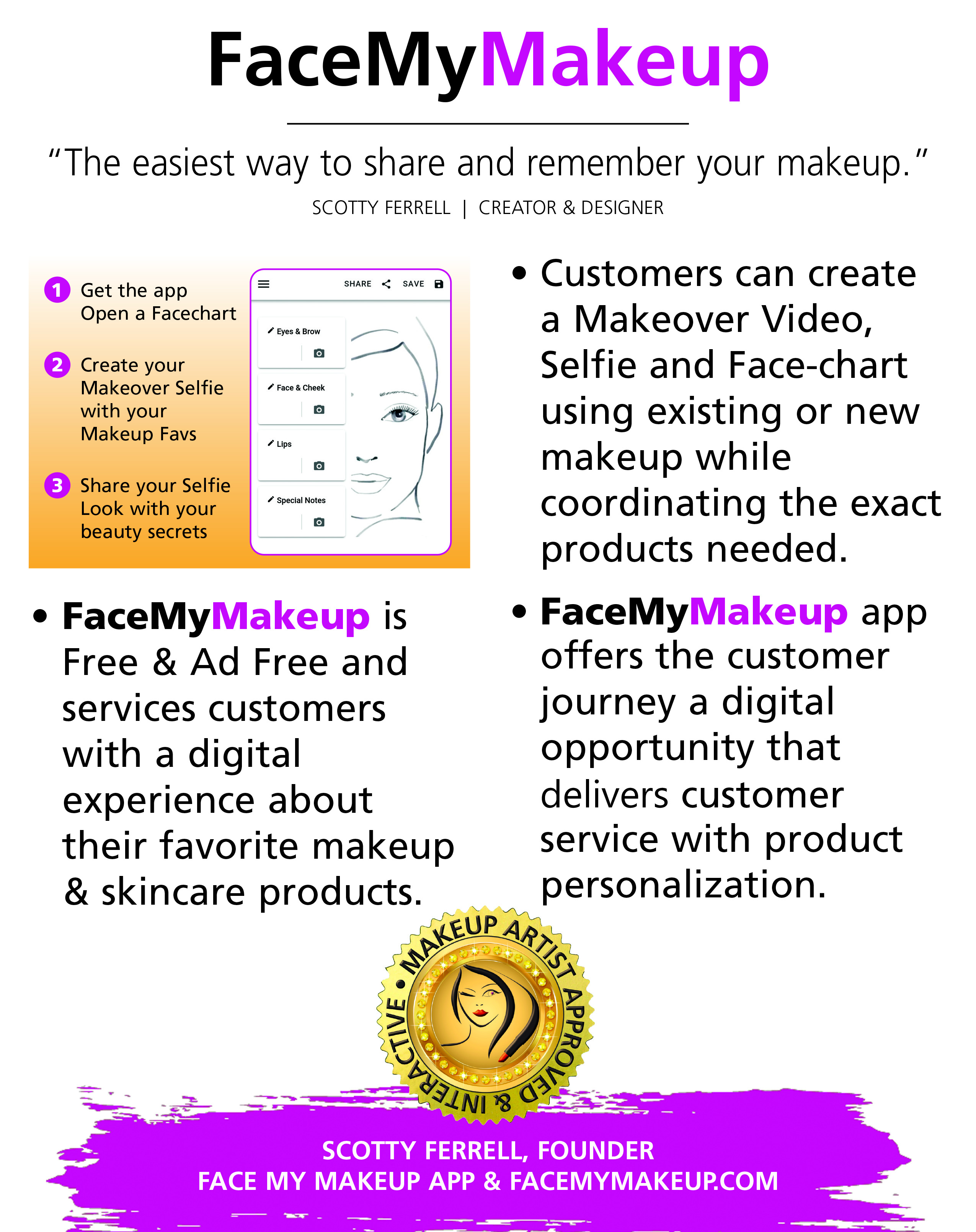
Face My Makeup app overview. Image provided by Scotty Ferrell.
MM: What are some of your favorite makeup trends or looks? (Can be current, can be historical, whatever you want!)
SF: Deep violet and emerald jewel tones playing off each other in the outer corner is to die for. I love an extended eyeliner that isn’t a cat eye but more Egyptian straight across with a softer edge. I think I still have a similar color story that I created for BABOR. A look I did paint on Jennifer Lopez on South Beach right after she made Selena. It was this beautiful tangerine and lime combination with shadows from Shu Uemura so super hot even though Jenny was less than nice.
MM: Anything else you'd like to add?
SF: I just want to get back on the team and do the work in beauty that I continue to see is still so necessary to produce results. Talking, listening to customers providing them service with the skills and experience to back it up; I’m there. Customers are demanding these conversations but those in charge have never painted a single face, ran an event with 100s of people making sure everyone leaves happy. Anticipating people’s needs and following up with a menu of choices is what it takes to grow a business. Translating this process digitally is doable but only from professionals that have touched faces with honest and real experiences. I mean why is Bobbi Brown now on Jones Road? Huge shout outs to forgotten greats, Alexander De Markoff, Stagelight, Germaine Monteil, Stendahl, PAYOT, Shu Uemura, and my ultimate favorite closest to my heart, Fernand Aubry!

The highly coveted Shu Uemura ME 945 eyeshadow
Thank you so much, Scotty, for this wonderful history you've provided! It's incredibly illuminating to get a first-hand account of how the makeup industry and trends change (or don't), and I'm so pleased to hear more about my favorite era. The Face My Makeup app sounds great, but I hope we see more of Gigi's creations in the future too. 😉 MM'ers: any thoughts?
I really enjoyed the shorter bits of history that appeared between chapters in Lisa Eldridge’s Face Paint. I liked the idea so much, in fact, that I decided to steal it and use it for my ’90s makeup history book. Prom makeup is just one of the many featurettes I want to include. And I realize that prom season has come and gone by this point, but I’m still thinking how crazy it is that I graduated high school and attended my senior prom 25 years ago this spring! So with that, let’s see what pop culture and magazine editorials were recommending in terms of prom makeup. Obviously this isn’t meant to be an exhaustive list of every ’90s prom look ever and how they compare to today’s styles, nor is it a philosophical examination of prom and its greater cultural or social significance, especially for teenage girls. This post is really more of a nostalgic snapshot, especially since sources were hard to find. There are tons of vintage prom photos online but the makeup is barely visible, either because analog photos rarely translate well to digital images or because they were taken at a distance. Very few clear, closeup images of old prom makeup exist, so I had to rely mostly on magazines, movies and TV episodes and they weren’t great quality either. Also, I credited where I could, but not all information was available for every photo.
Overall, the decade followed the general makeup trends of the time. As a sort of backlash to the bright colors and general excess of the ’80s, from about 1990-1994 the majority of prom looks featured minimal, barely perceptible makeup.
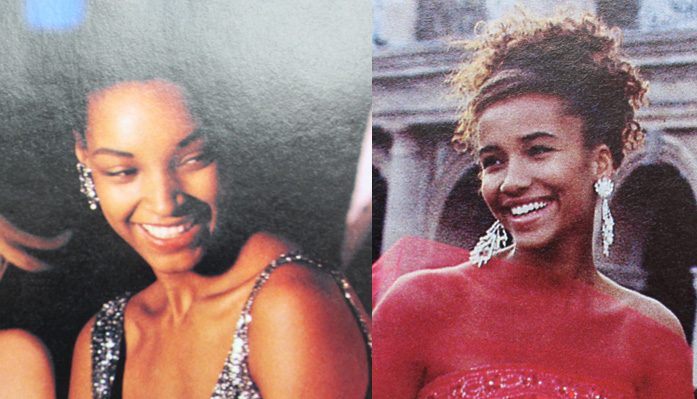
Minimal prom looks from Seventeen Magazine, 1992 (left) and 1991 (right). Credits for 1992: Hair – Hubert Cartier and Gili. Makeup: Timothy Metz. Photography: Wayne Stambler. Credits for 1991: Hair – Rodney Groves; Makeup – Timothy Metz; Photography – Tierney Gearon.
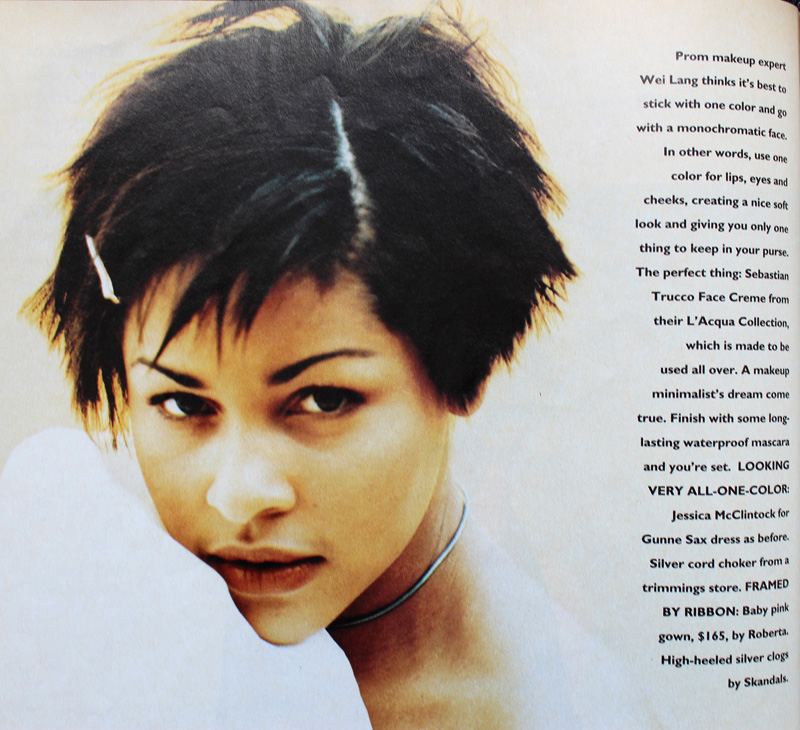
Sassy Magazine, 1993. Hair – Daniel Howell; Makeup – Wei Lang; Photography – David Jensen
Are these girls even wearing makeup?! I guess they are since the credits list a makeup artist, but it’s nearly invisible.
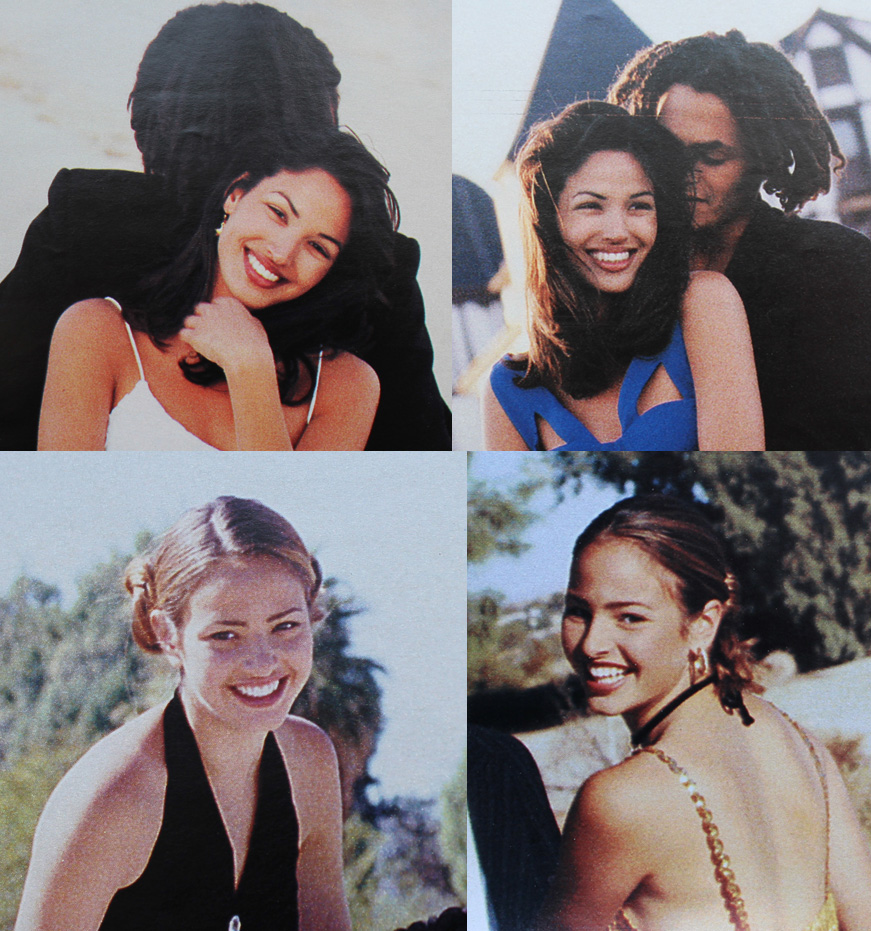
YM Magazine prom edition, 1994. Credits for top photos: Hair – Christopher Lockhart for Sarah Laird; Makeup – Christy Coleman for Jed Root, Inc. Credits for bottom photos: Hair – Brent Lavent for Celestine; Makeup – Laura Jadro for Visage; Photography – Carlo Dalla Chiesa
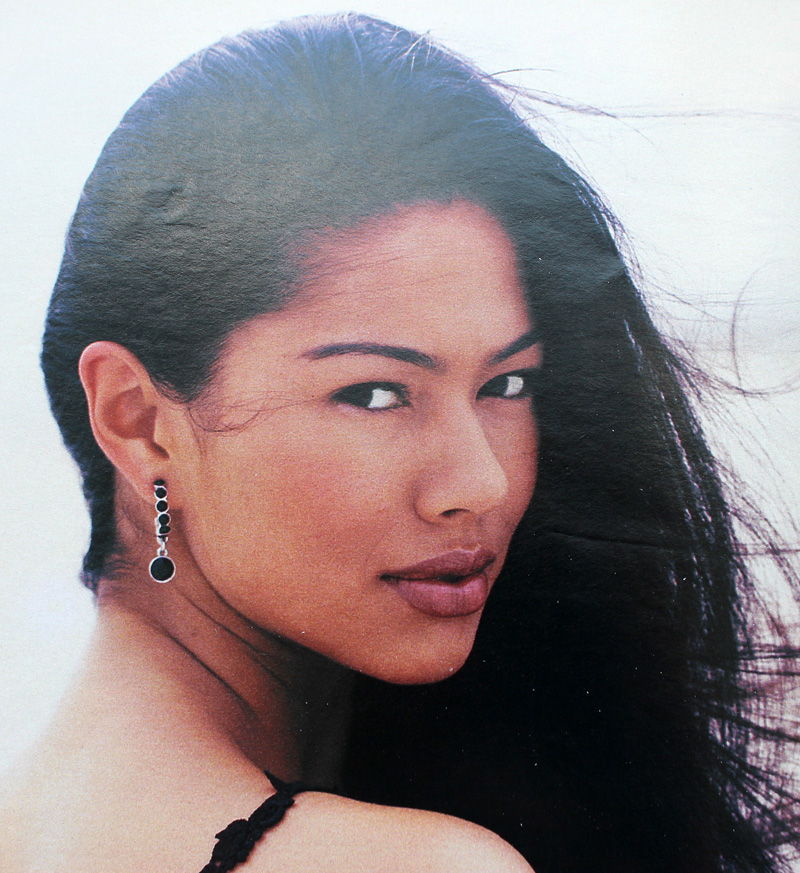
YM Magazine prom edition, 1994. Hair – Christopher Lockhart for Sarah Laird; Makeup – Mathew Sky for Vartali Salon. Makeup by Maybelline.
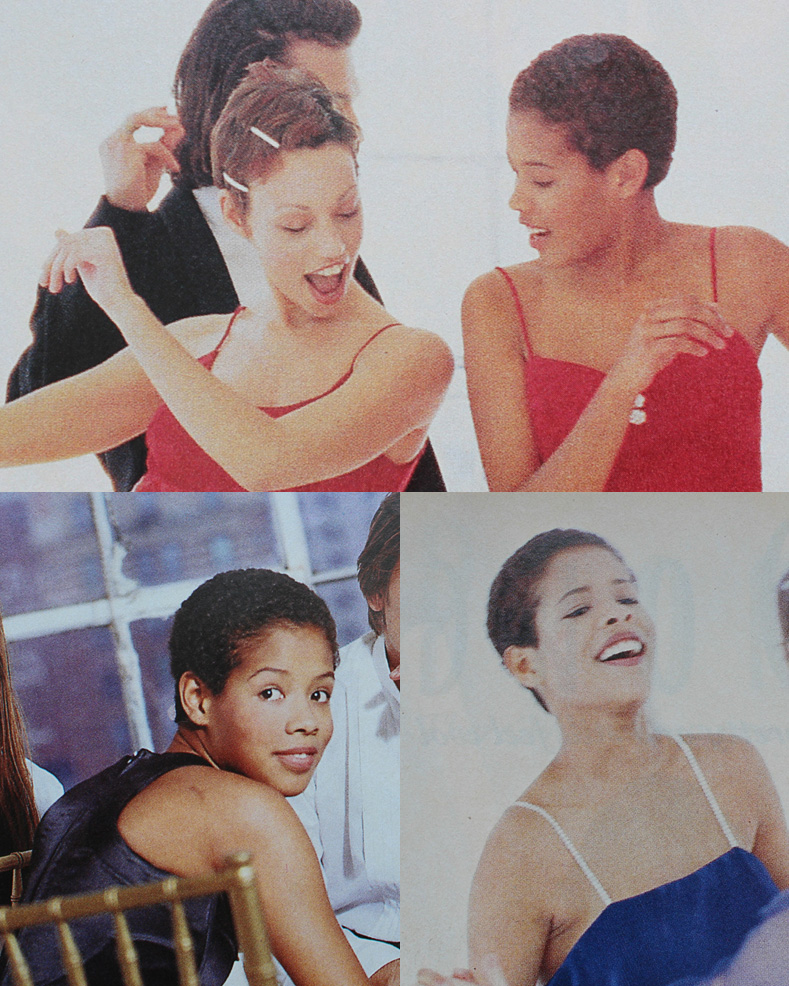
Sassy Magazine, March 1994. Hair – Daniel Howell for Oribe; Makeup – Regina Harris; Photography – Cathrine Wessel
Julia Stiles’s character in 1999’s 10 Things I Hate About You opted for a minimal look for prom, but this might have been more of a stylistic choice to go match her personality rather than a reflection of late ’90s trends. Kat Stratford would never go for the glitter, frost and pastel colors that were popular towards the end of the decade.
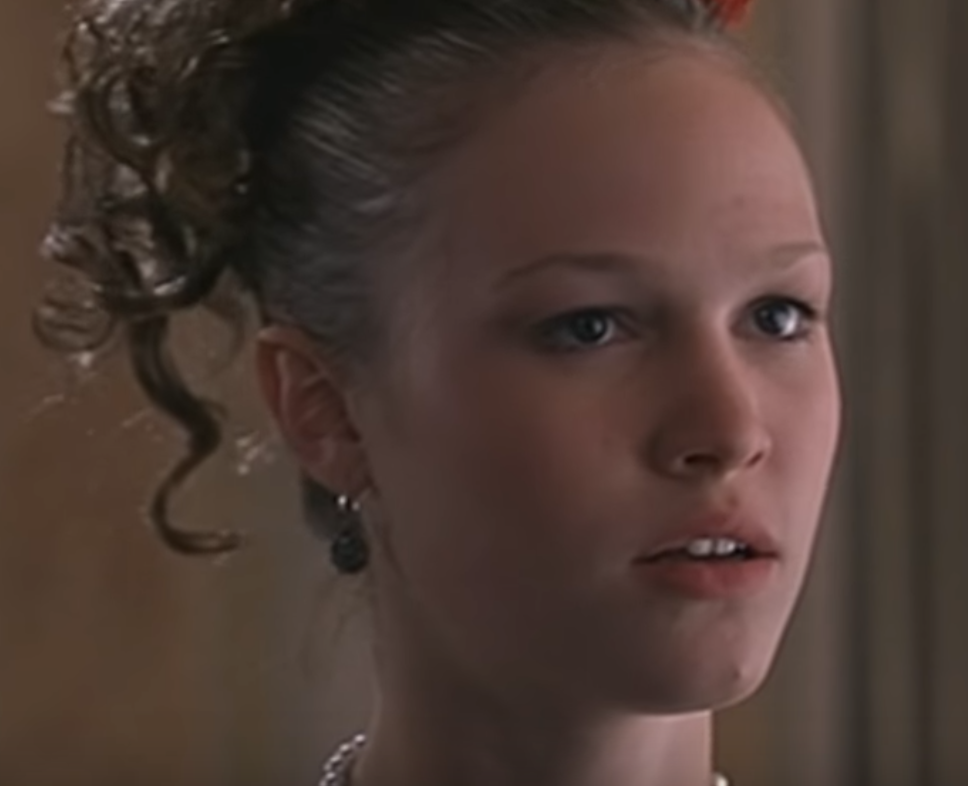
Julia Stiles as Kat Stratford in 10 Things I Hate About You, 1999. Makeup artist: Martin ‘Vinnie’ Hagood
Another trend early on was a return to old school glam. Red matte lips, with or without a winged liner but always keeping the rest of the face neutral, was a popular choice.
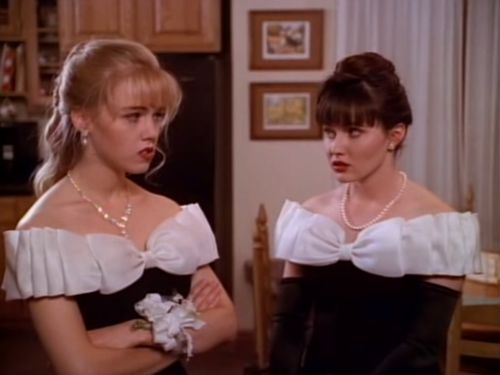
Kelly (Jennie Garth) and Brenda (Shannen Doherty) in Beverly Hills, 90210 “Spring Dance” episode, 1990. Key makeup artist – Sheree Morgan; makeup artist – Alex Proctor.
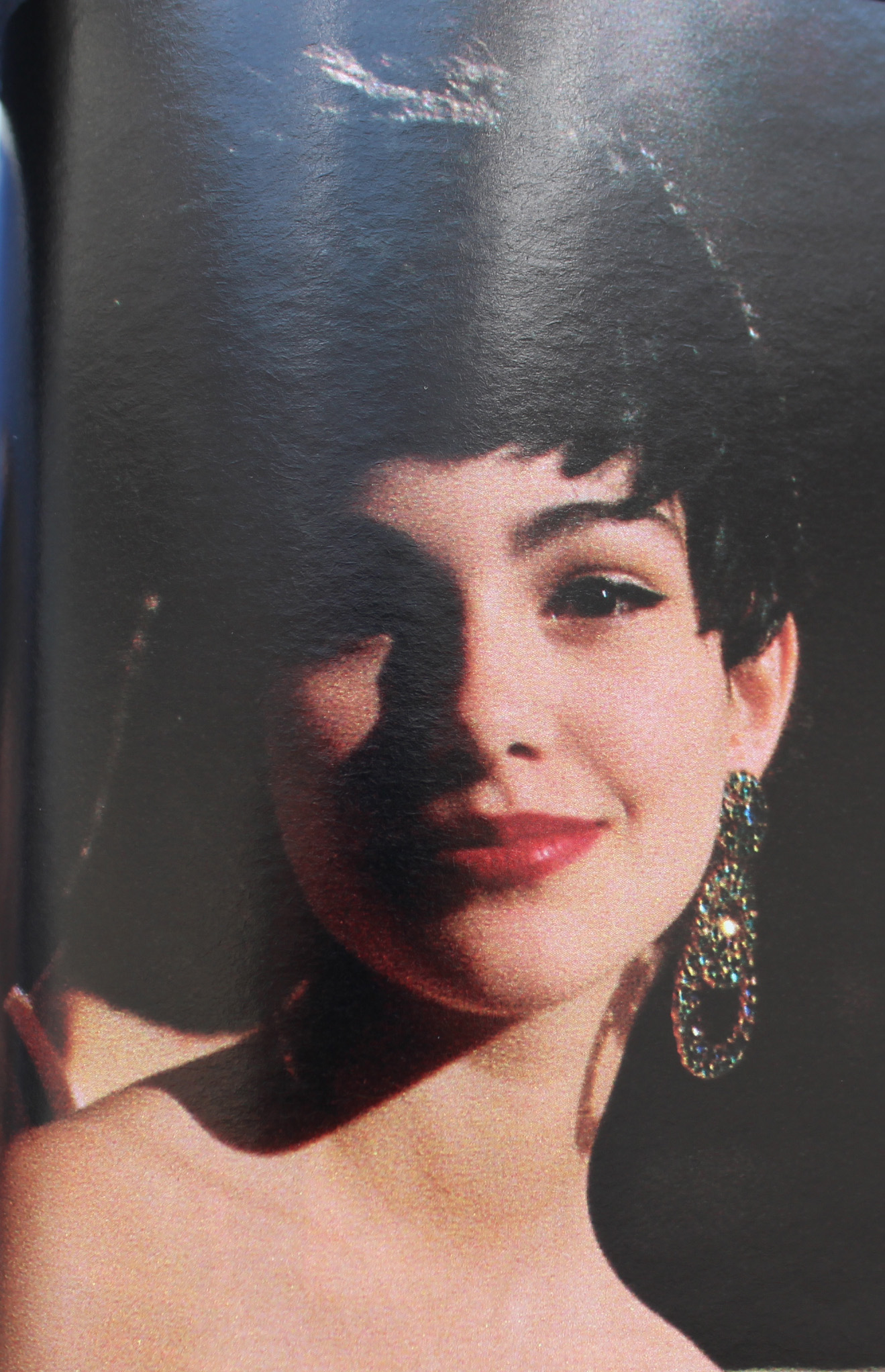
Seventeen Magazine, March 1991. Hair – Gabriel Saba for John Sahag Salon; Makeup – Jacqui Lefton; Photographer – Dewey Nicks; Model – Limor Luss
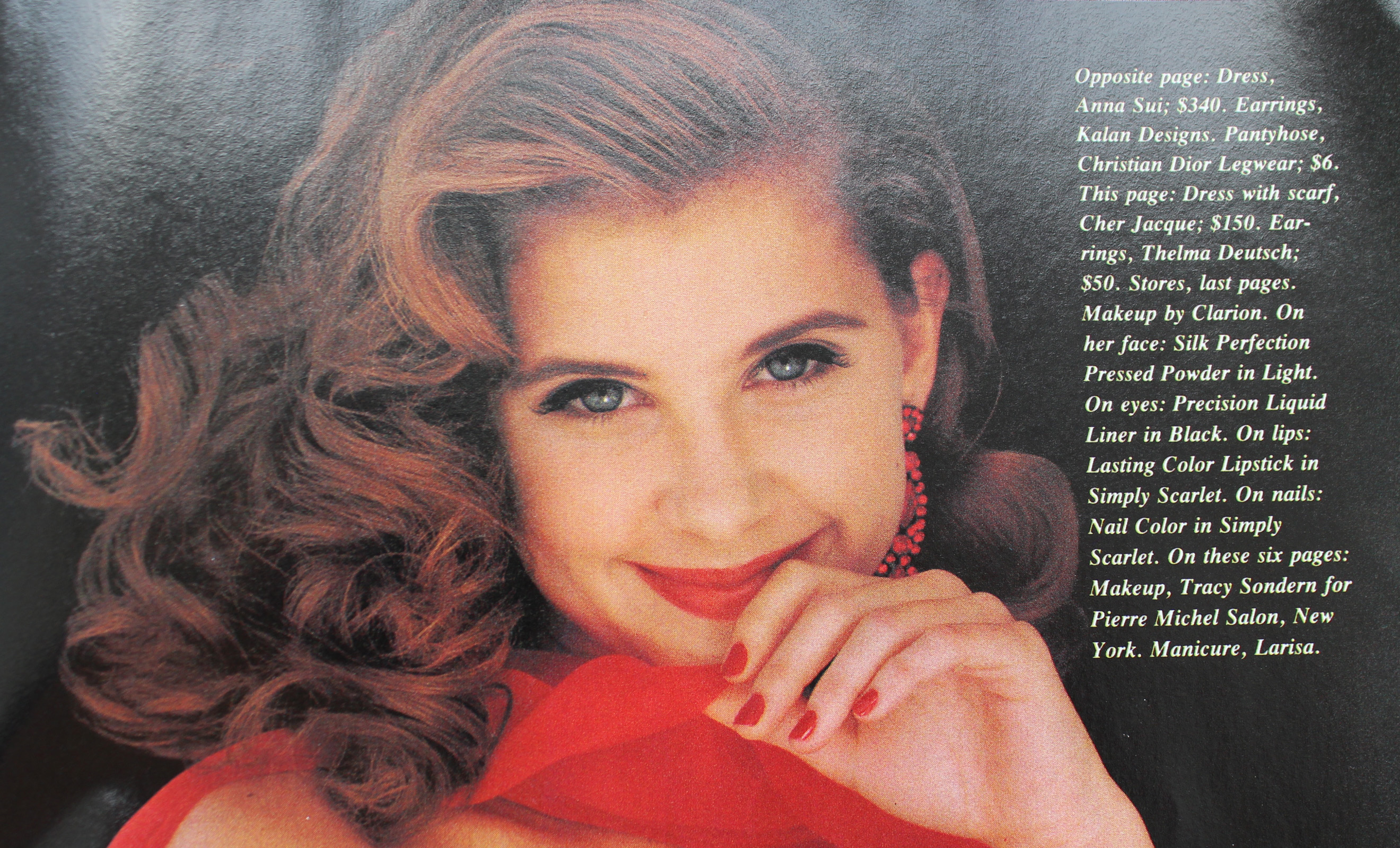
Kellie Martin in Seventeen Magazine, March 1992. Hair – Patrick Melville for MCM Salon; Makeup – Tracy Sondern; Photography – Bico Stupakoff
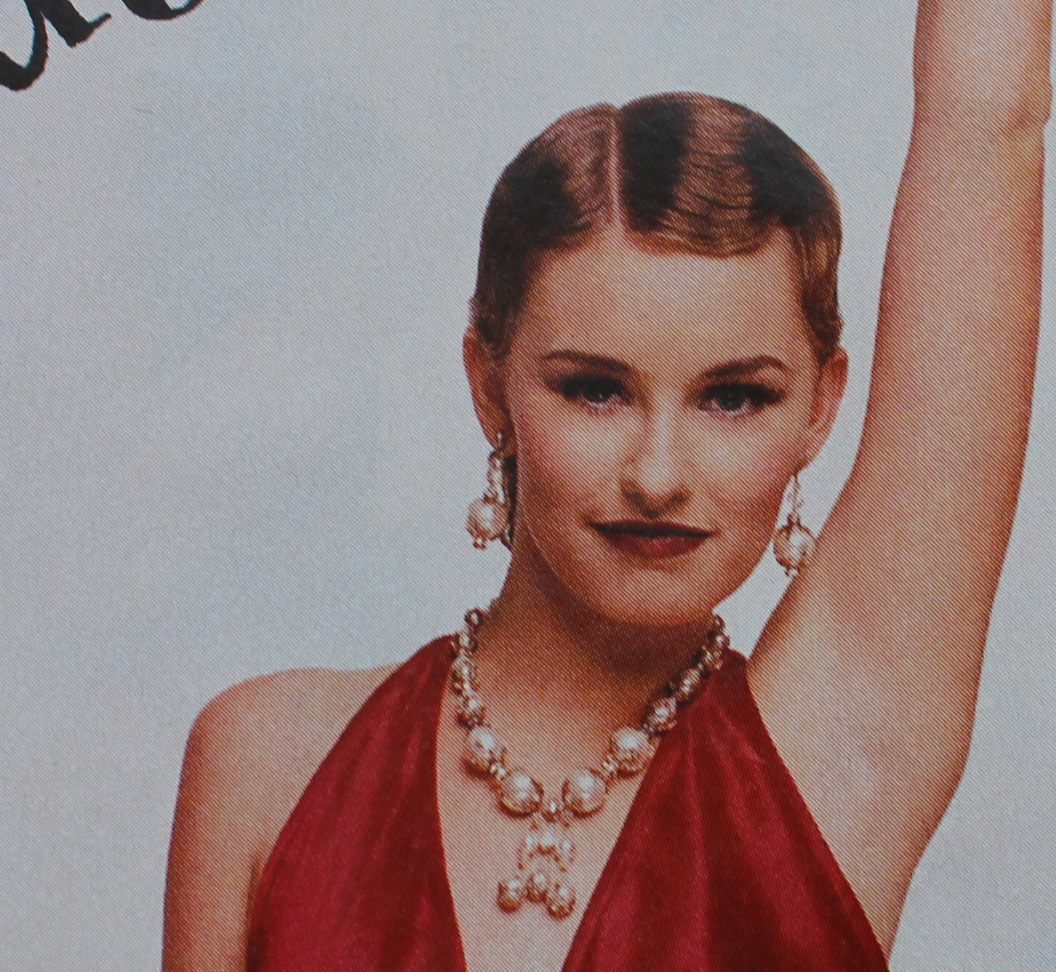
Sassy Magazine, March 1995. Hair – Diane Wiedenmann; Makeup – Sharon Gault for Cloutier
Again, as with 10 Things I Hate About You‘s Kat, I think Heather’s (Mena Suvari) red lip more a stylistic choice to better suit the character rather than part of a real-world trend. (Sorry about the lack of quality in this photo, I couldn’t find a decent shot anywhere. Also, no fewer than 7 makeup artists for American Pie are listed at IMDB so it’s not clear who chose her look.)
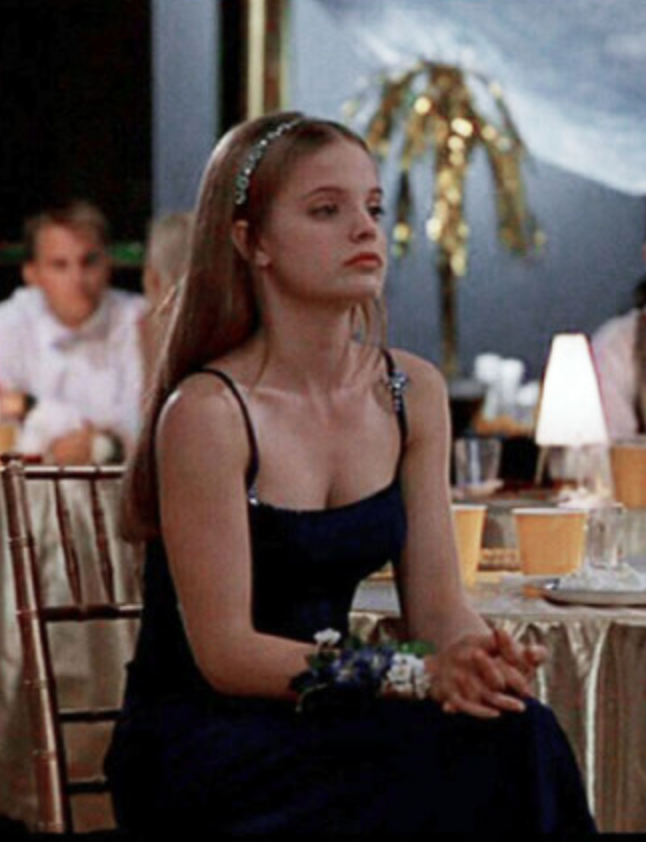
Just based on these candids from YM’s prom issues, it seems like a lot of girls opted for a red lip or the minimal look for prom for 1993 and 1994.
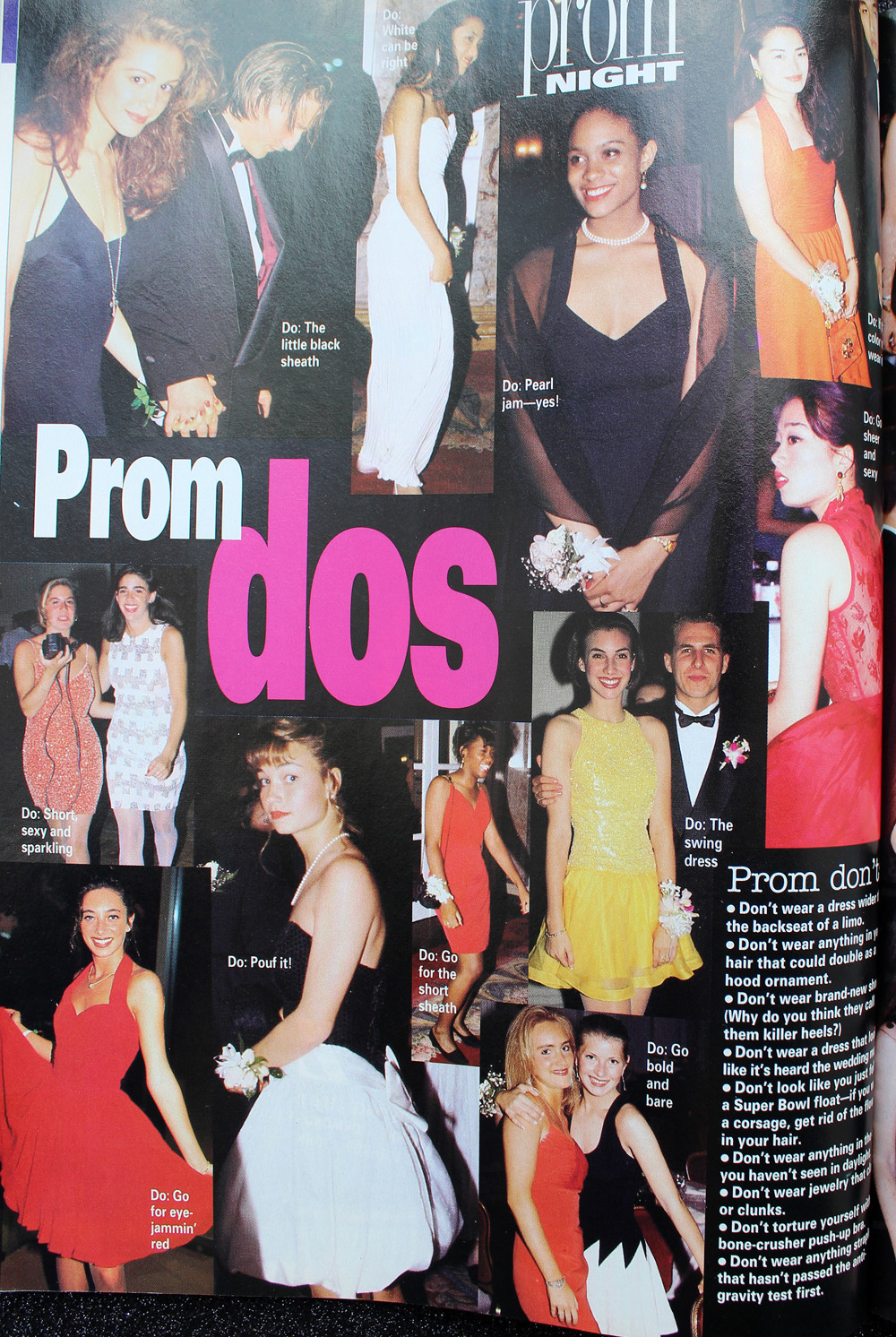
YM Magazine prom edition, 1993
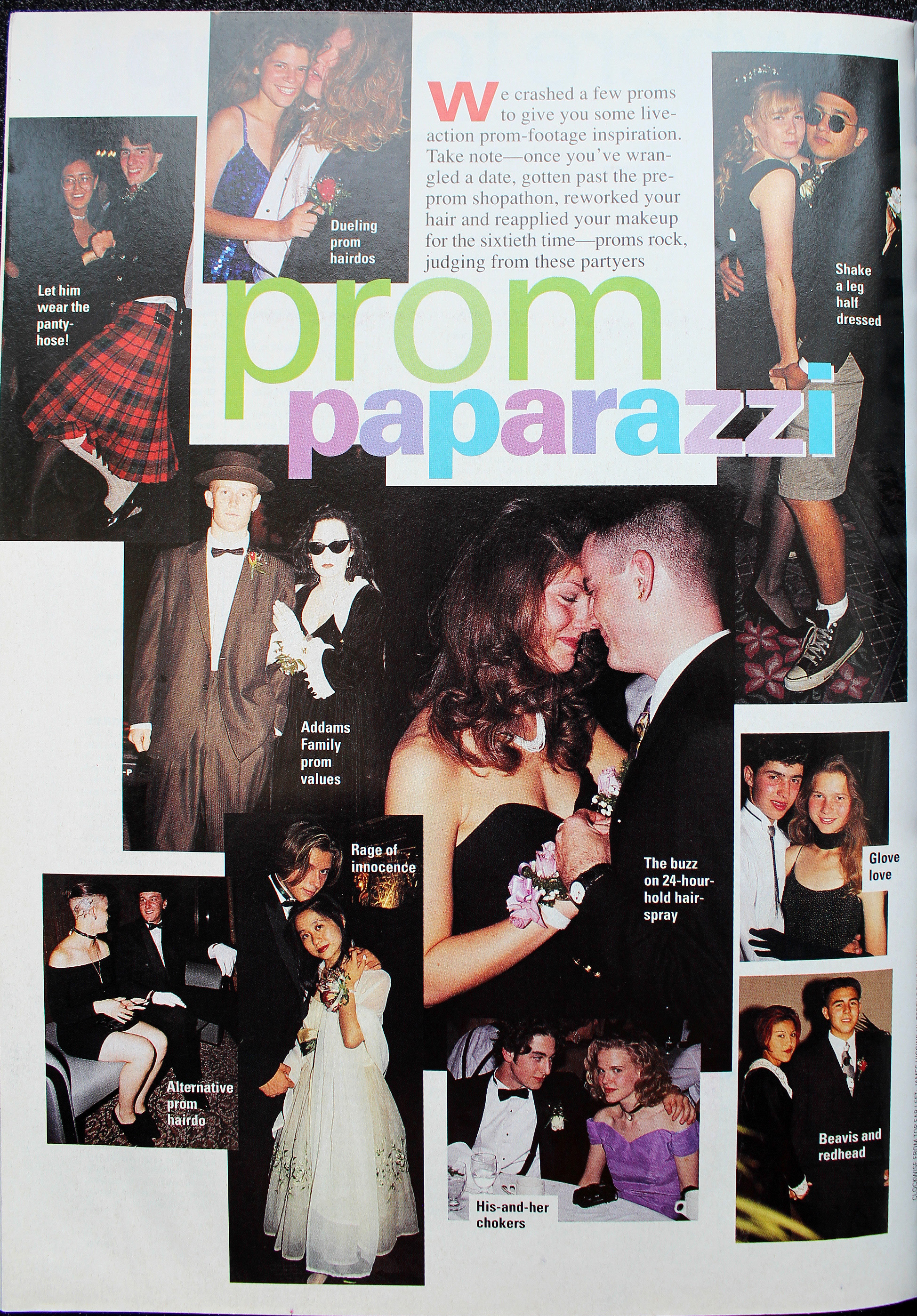
YM Magazine prom edition, 1994
There was also a somewhat odd combination of soft smoky matte grey or brown shadow and a desaturated but noticeable lip color. I don’t really remember this look, probably because I can’t say that the early ’90s take on a smoky eye is a look I enjoy. It just looks flat and muddy, plus very amateur despite the professional application. It’s like someone dipped their fingers into shadow, swiped them across their lids, added a touch of mascara and declared their eye makeup finished. Which would be fine with different textures and shades, but matte shadow in these colors requires some definition.
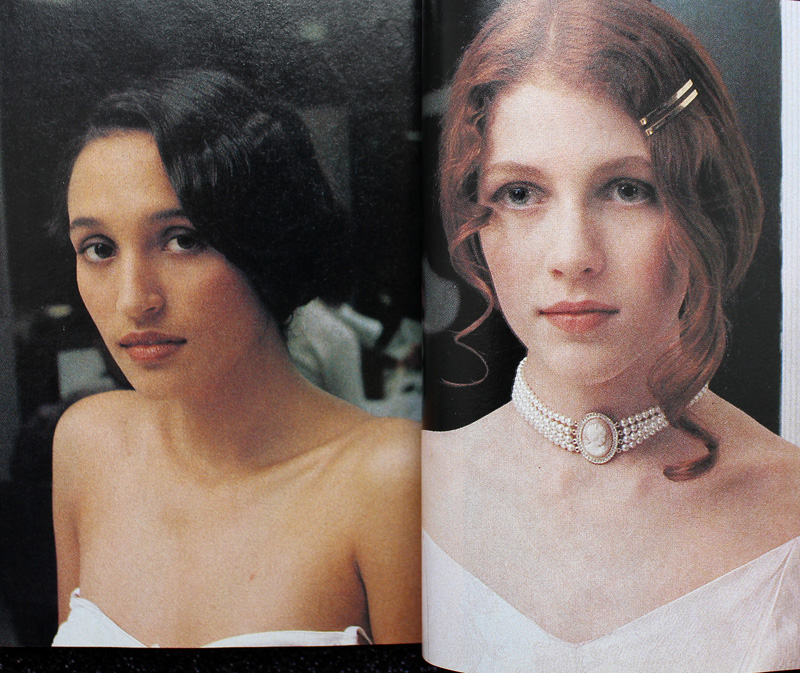
Seventeen Magazine, March 1992
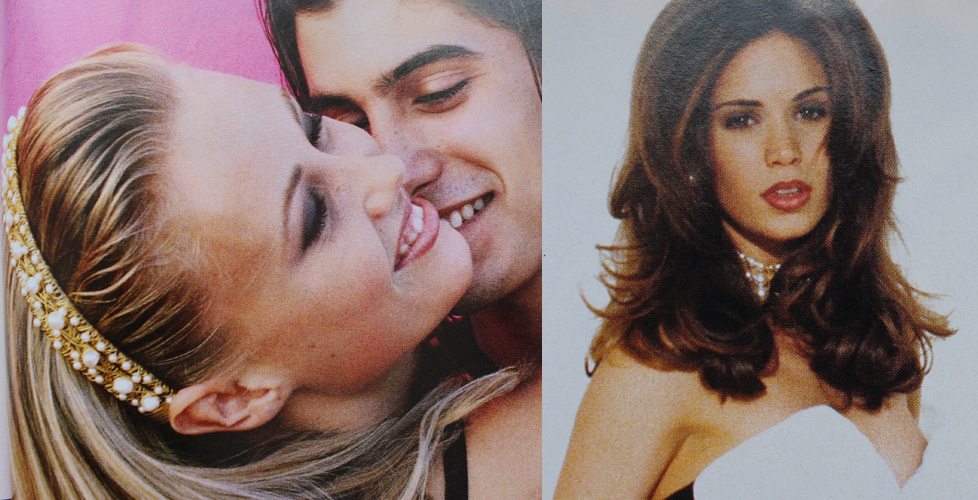
YM Magazine prom edition 1993
My opinion is that it suits nobody, not even Heidi Klum.
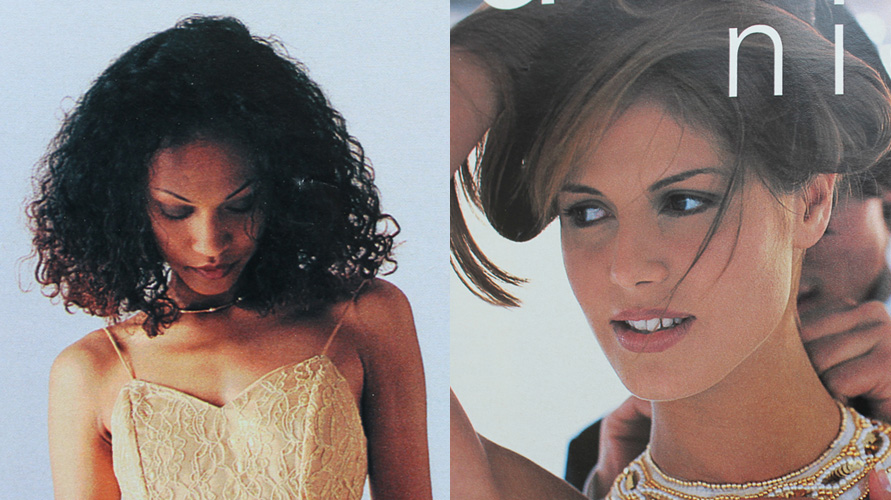
YM Magazine prom edition 1994. Credits for left photo: Gerald DeCock for Louis Licari Color Group; Makeup – Christy Coleman for Jed Root, Inc. Credits for right photo: Hair – Lawrence DePalma for Pierre Michel Salon; Makeup – Christy Coleman for Jed Root, Inc. Model: Heidi Klum
A monochromatic face is surprisingly artistic and flattering if there’s variation in textures and finishes between eyes, cheeks and lips. Matte brown shadow with seemingly no other eye makeup besides a hint of mascara and paired with a warm, orange-brown lip isn’t great on most people. Case in point: these prom looks from the March 1994 issue of Seventeen. I know they were really meant to show the hairstyle, but they are so boring! Plus it looks awful on the skin tone of the particular model that was chosen – the poor thing looks like the life got sucked out of her. This combination only works on very specific coloring.
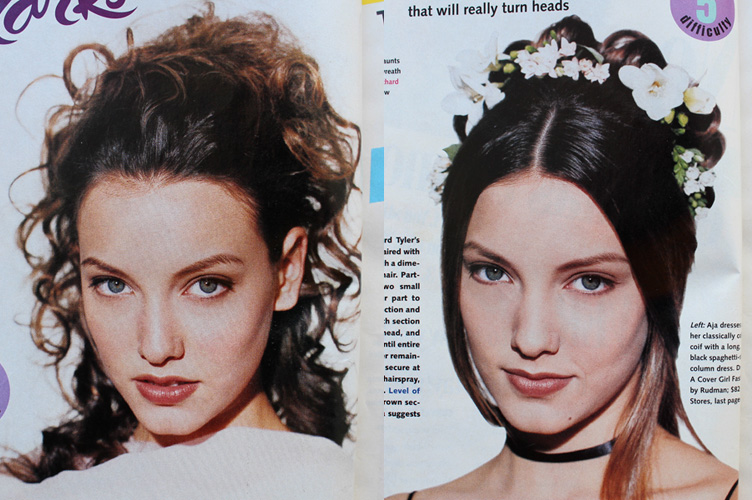
Seventeen Magazine, March 1994. Hair – Mara Schiavetti; Makeup – Cindy Joseph
Matte, one-dimensional shadow works if the eyeliner is noticeably darker and there is a contrast in tone for the lip color, as in YM‘s 1993 prom editorial.
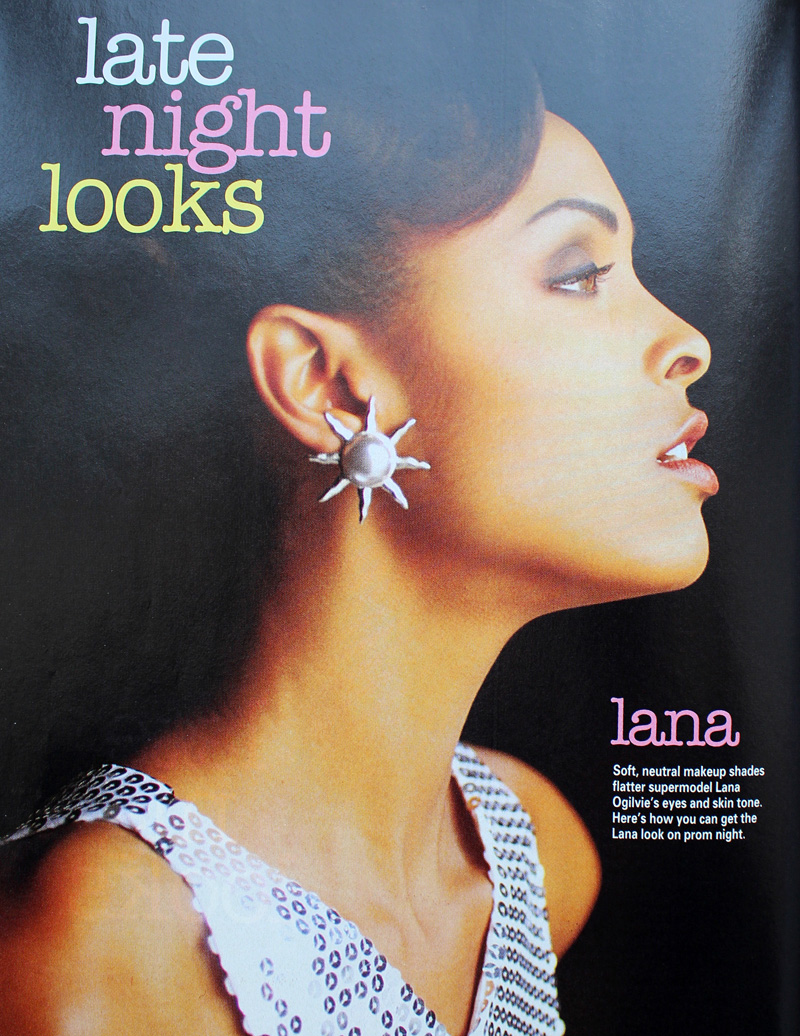
YM Magazine prom edition, 1993. Model: Lana Ogilvie. Makeup Artist: Craig Gadson for Cover Girl.
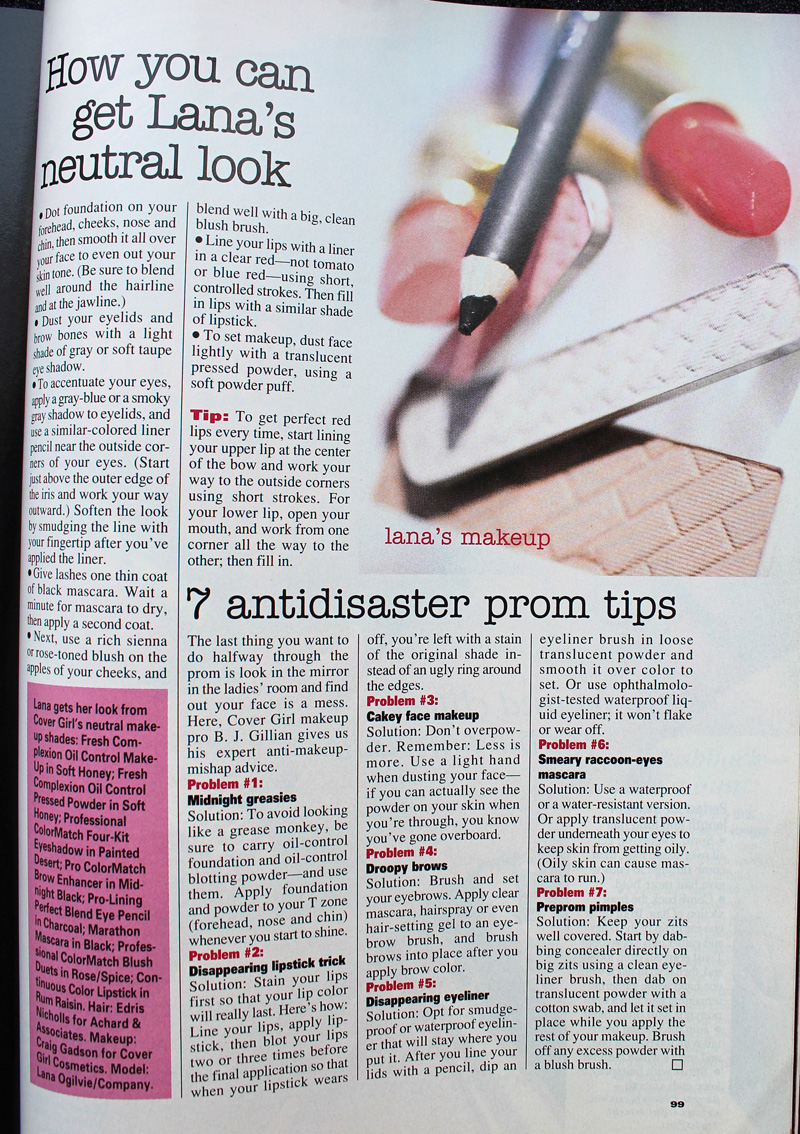
But there is hope. Around 1996 is when we start to see a move away from matte textures and neutral shades. Bring on the metallics, the frost, the GLITTER!!
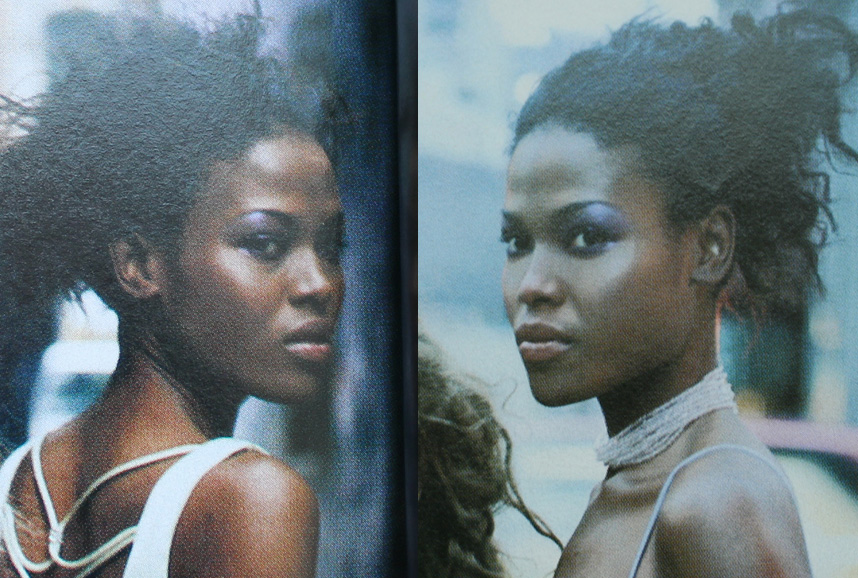
Seventeen Magazine, March 1997. Hair – Dennis DeVoy for Garren New York; Makeup – Kiyoshi for Oribe Salon; Photography – Iris Brosch
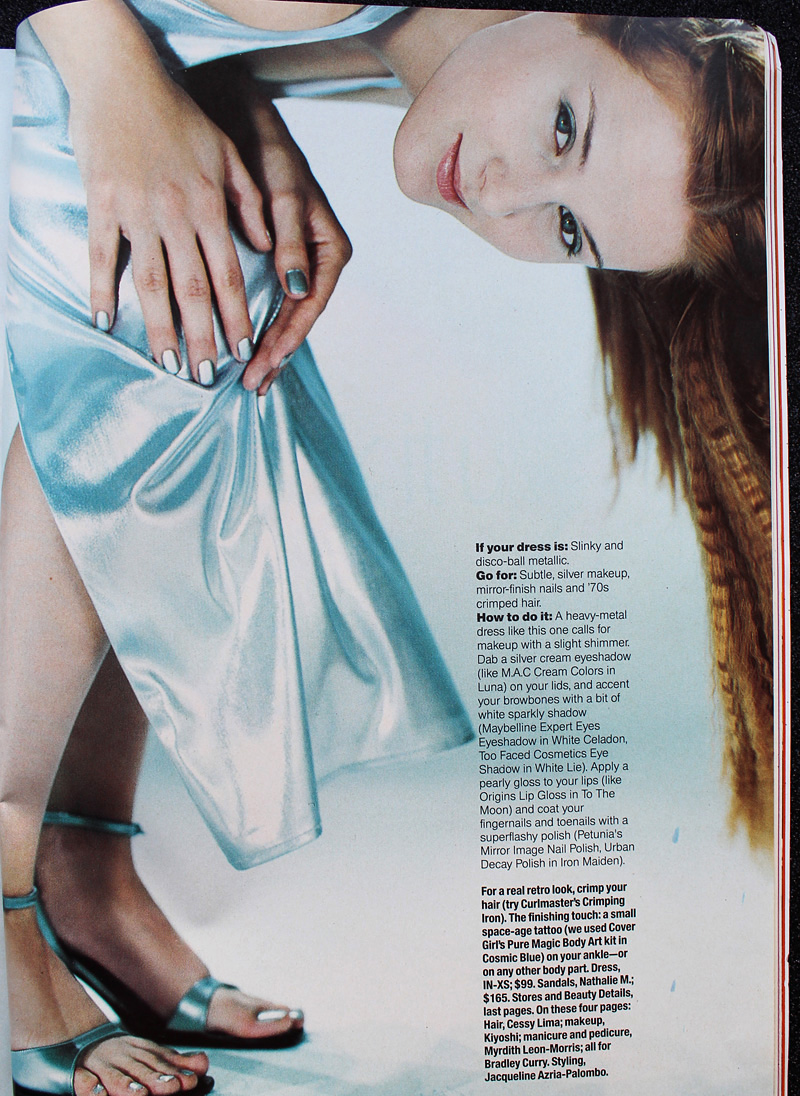
Seventeen Magazine, March 1999
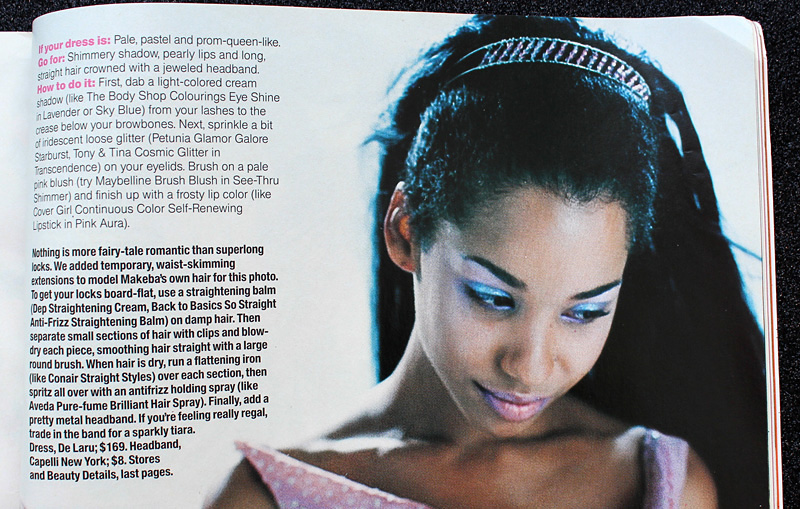
Seventeen Magazine, March 1999
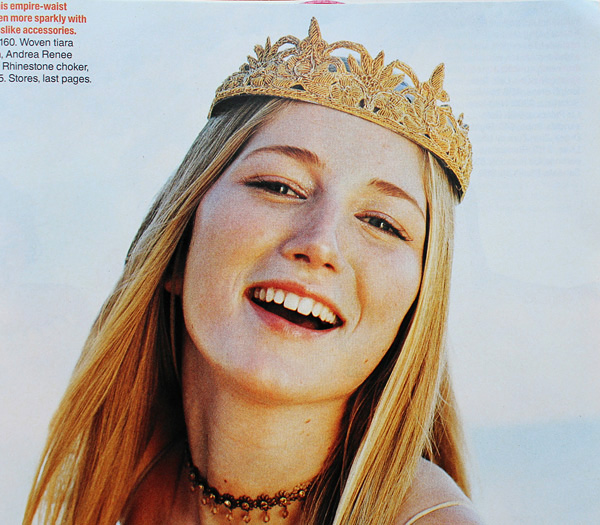
Seventeen Magazine, March 1999
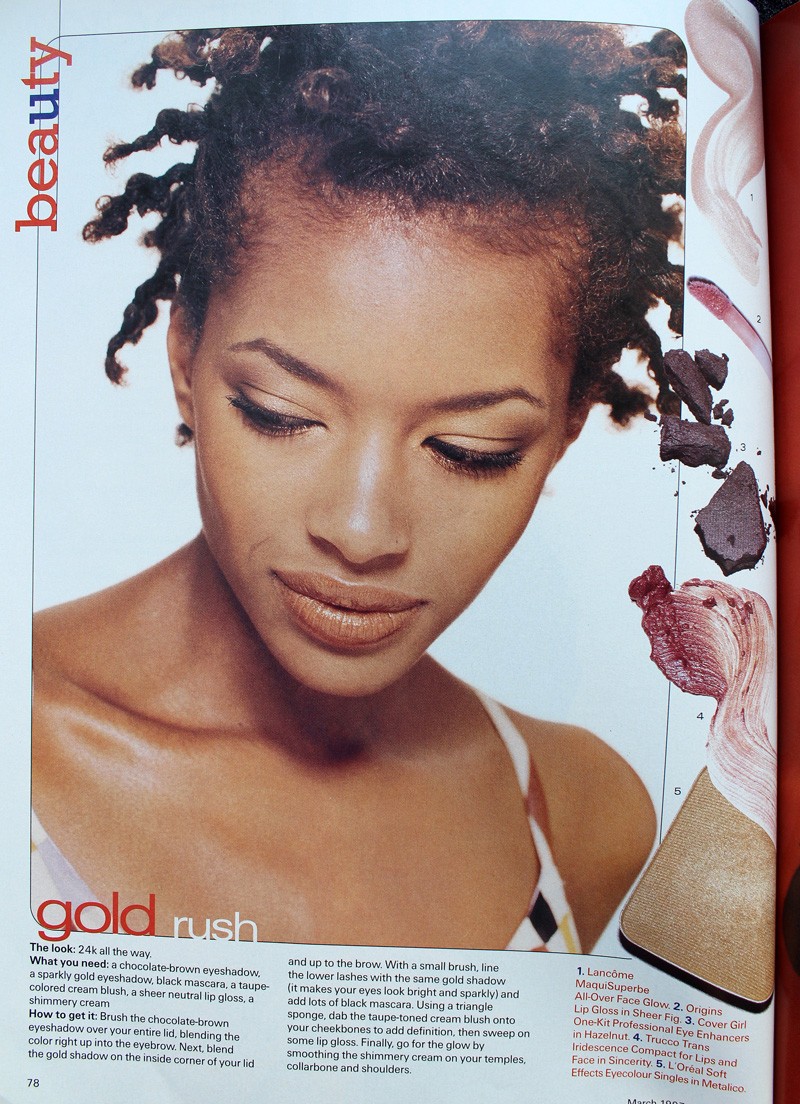
Seventeen Magazine, March 1997. Hair – Matthew Williams; Makeup – Virginia Carde; Still life photos – Aimeé Herring; Model photos – Olivia Graham
There were literally dozens of makeup artists who worked on Buffy the Vampire Slayer, so I’m not sure who was responsible for Buffy’s prom makeup, which consisted of a soft silvery grey eyeshadow and pearly pink gloss.
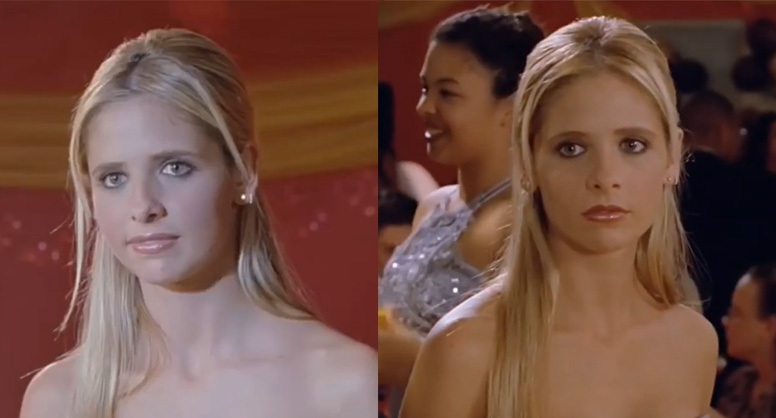
Sarah Michelle Gellar in “The Prom” episode of Buffy the Vampire Slayer, 1999
Complexion-wise, foundation was less heavy and flat. Even though the early ’90s embraced the minimal look, skin still looked a bit dull. There were also few glossy lips to be found. The later part of the decade witnessed a shift towards fresher-looking skin (perhaps more blush added to this effect) and the rise of super shiny lips, which would continue into the early 2000s.
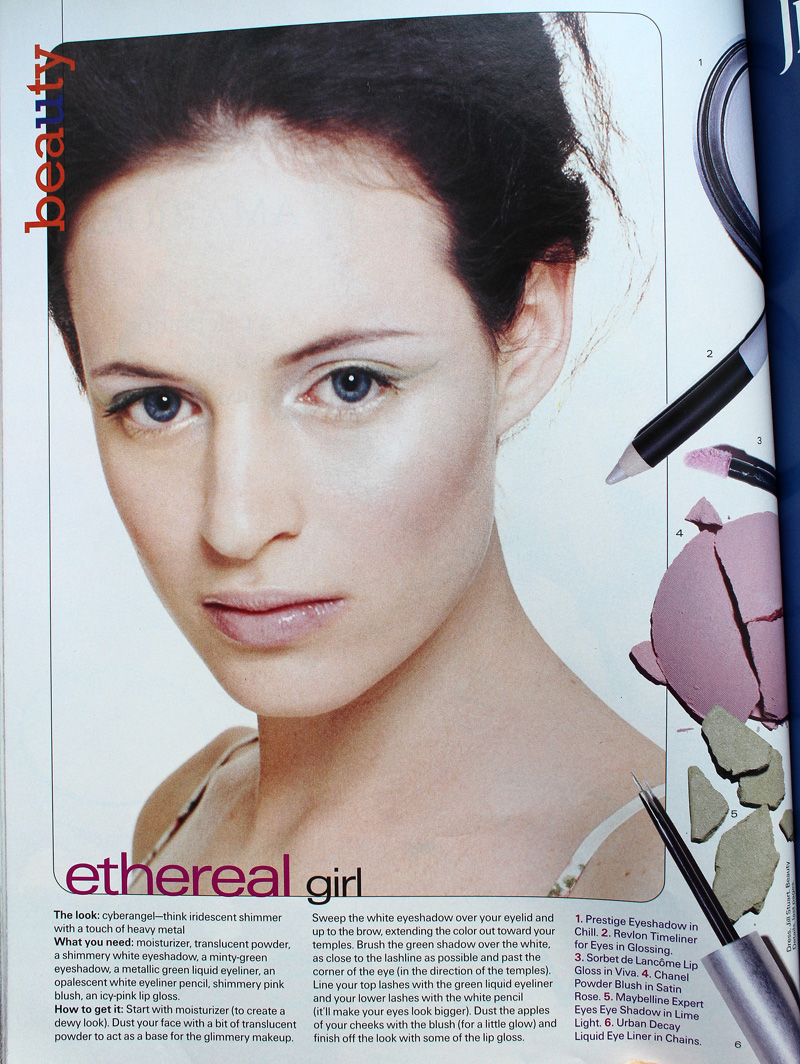
Seventeen Magazine, March 1997. Hair – Matthew Williams; Makeup – Virginia Carde; Still life photos – Aimeé Herring; Model photos – Olivia Graham
Also, there was interest in color again – no longer was the palette limited mostly to red, pink, grey and brown. Blue, peach, yellow, violet and green peeked their eager little faces out for the first time in what seemed like ages.

Sassy Magazine, March 1996
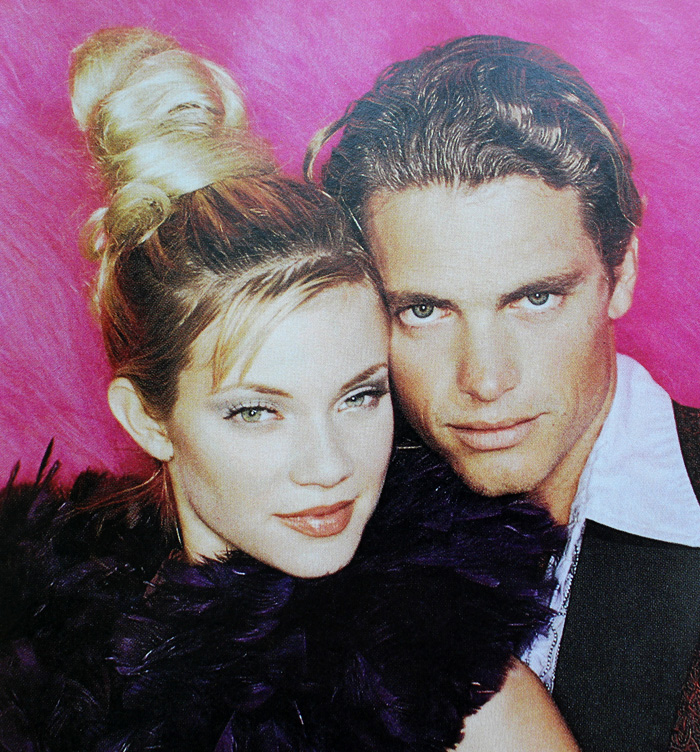
Sassy Magazine, March 1996
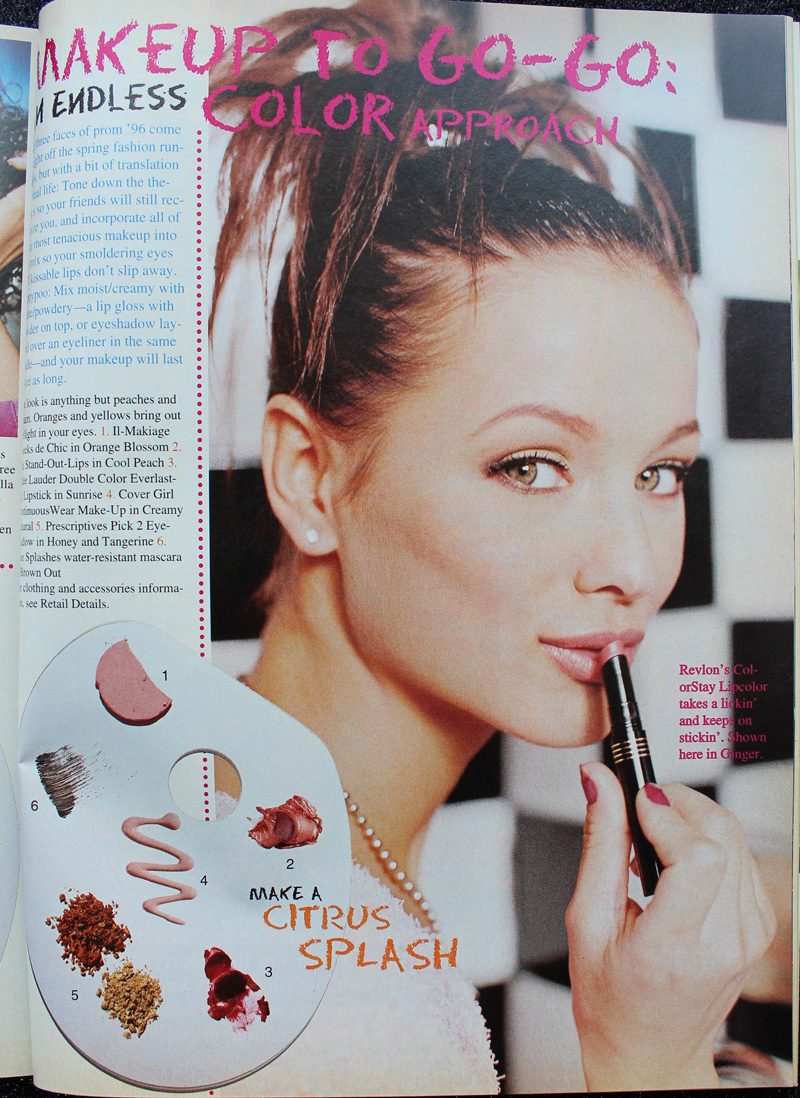
Sassy Magazine, March 1996
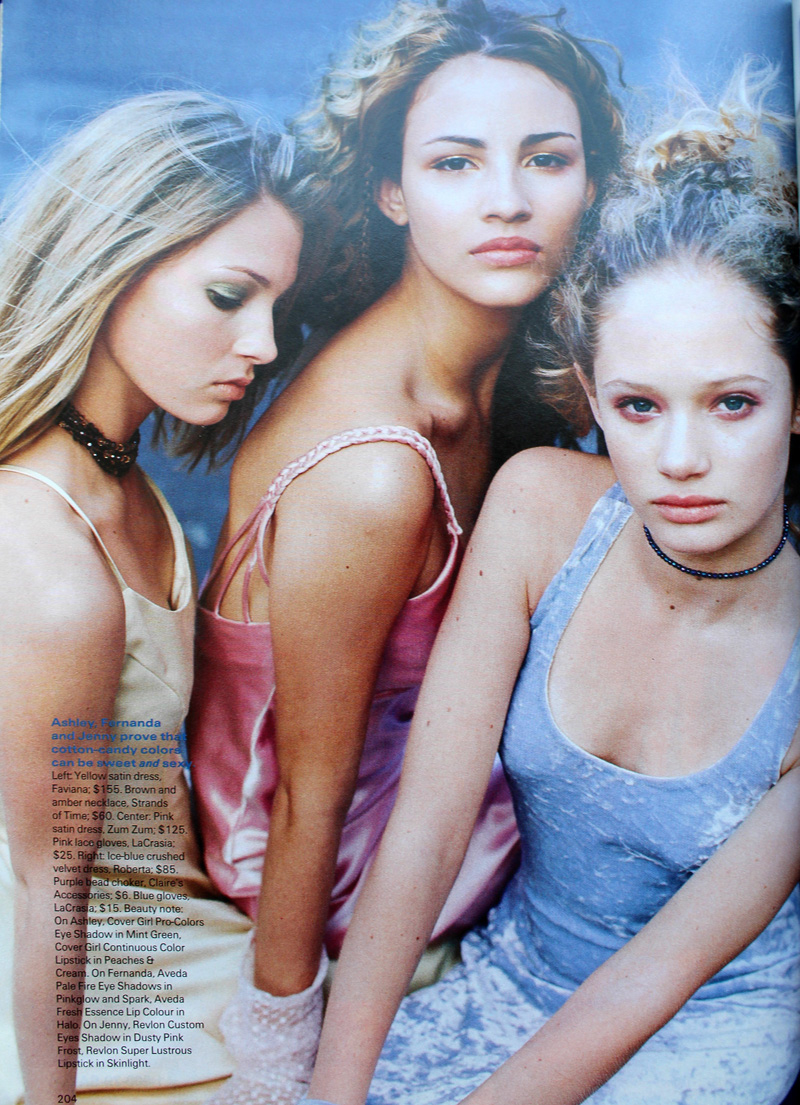
Seventeen Magazine, March 1997. Hair – Dennis DeVoy for Garren New York; Makeup – Kiyoshi for Oribe Salon; Photography – Iris Brosch
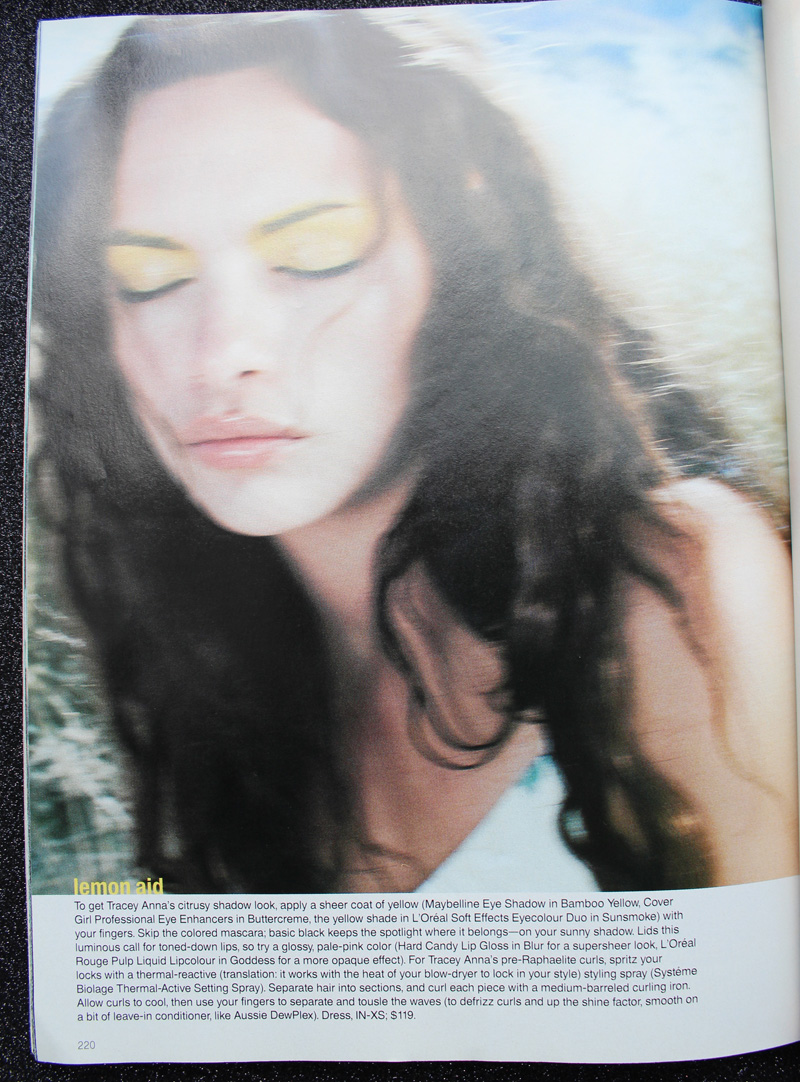
Seventeen Magazine, March 1998. Hair – Kevin Woon; Makeup – Kiyoshi; Photography – Marc Baptiste
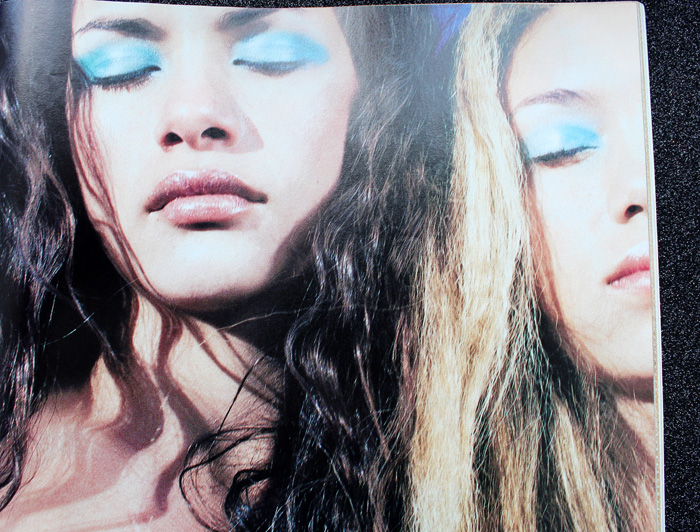
Seventeen Magazine, March 1998. Hair – Kevin Woon; Makeup – Kiyoshi; Photography – Marc Baptiste
I really wish I could have found better photos of the makeup in prom scenes from movies and TV. (Seriously though, what was up with all the prom sequences in films from 1999? It seems nearly every teen movie made that year had one.) In these stills that I screenshotted and tried to brighten from She’s All That you can sort of make out Laney’s violet eyeshadow and browbone highlight.
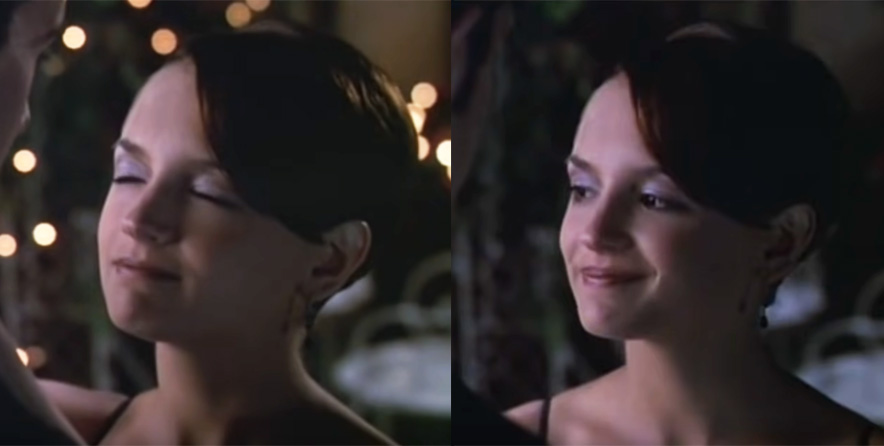
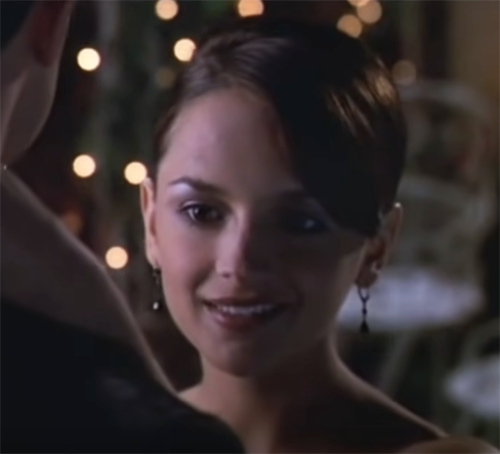
Rachel Leigh Cook as Laney Boggs in She’s All That, 1999. Head makeup artist – Felicity Bowring; Makeup artists – Raqueli Dahan, Jane Galli and Lisa Layman
Meanwhile, mean girl Taylor Vaughan (Jodi Lyn O’Keefe) rocked a monochromatic gold look, complete with face and body glitter. Peak ’90s!
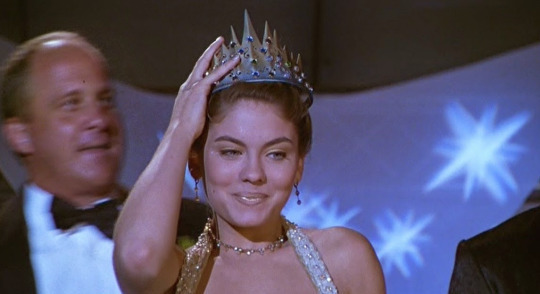
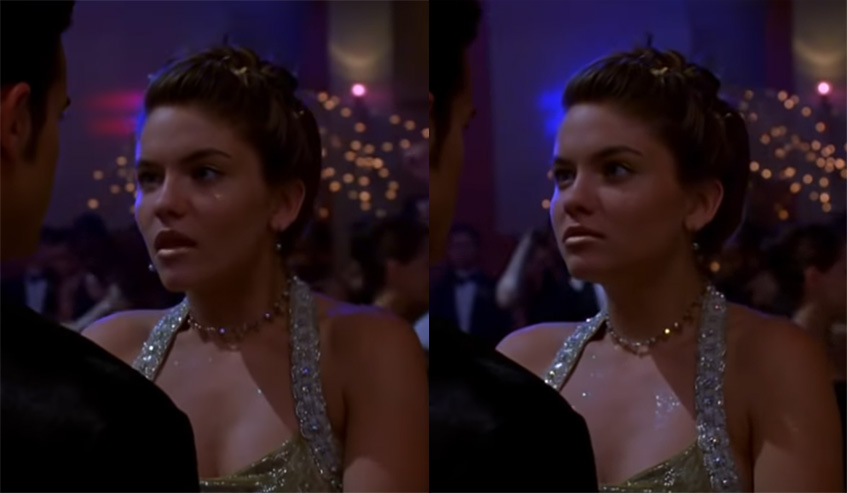
And let’s not forget Courtney’s epic frosty blue eyeshadow in 1999’s Jawbreaker. Once again there was a huge makeup department so whose idea it was I’m not sure.
Now there were some trends that appeared in various iterations throughout the whole decade rather than being confined to certain years. Pink reigned supreme for prom makeup in the ’90s. Whether it was full-on bubblegum or a more natural, “romantic” look, rosy hues were a staple.
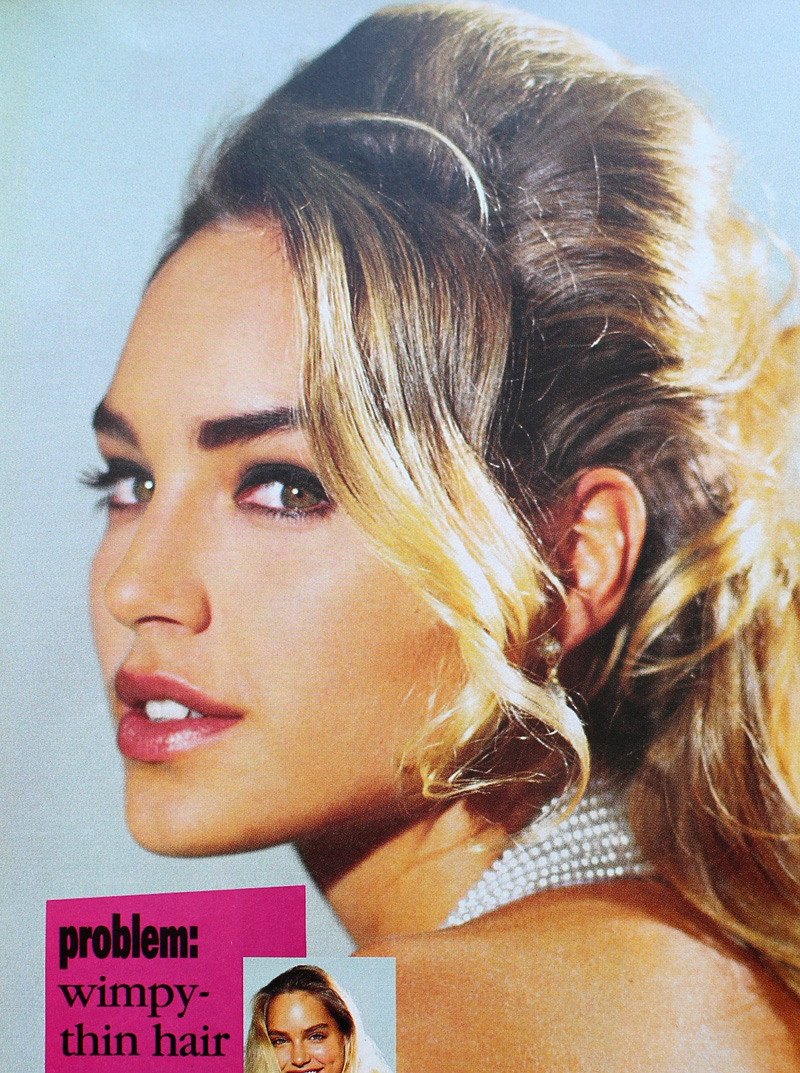
YM Magazine prom edition 1992. Hair – Brian Devine, Oribe at Elizabeth Arden; Makeup – Melissa Rogers
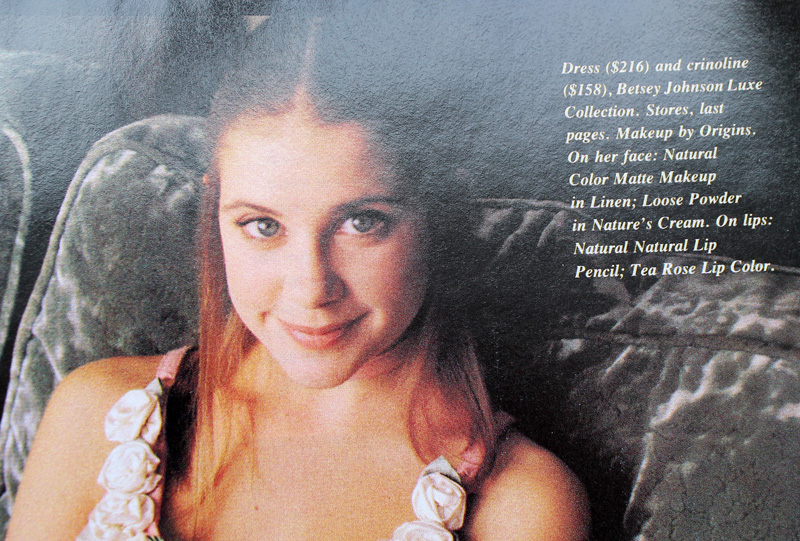
Kellie Martin in Seventeen Magazine, March 1992. Hair – Patrick Melville for MCM Salon; Makeup – Tracy Sondern; Photography – Bico Stupakoff
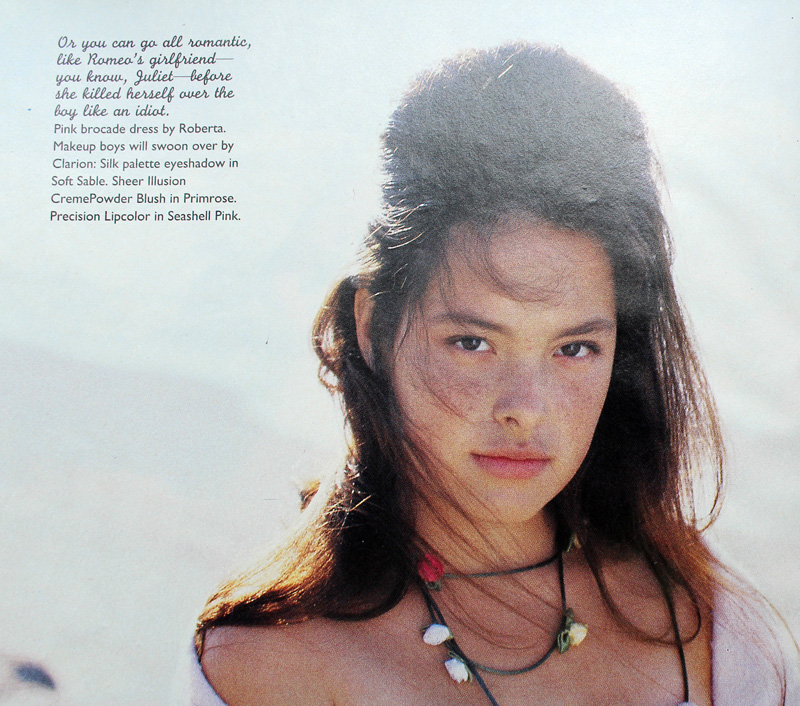
Sassy Magazine, March 1992. Hair – Colleen Creighton for Pierre Michel; Makeup – Lutz; Photography – Steven Miller
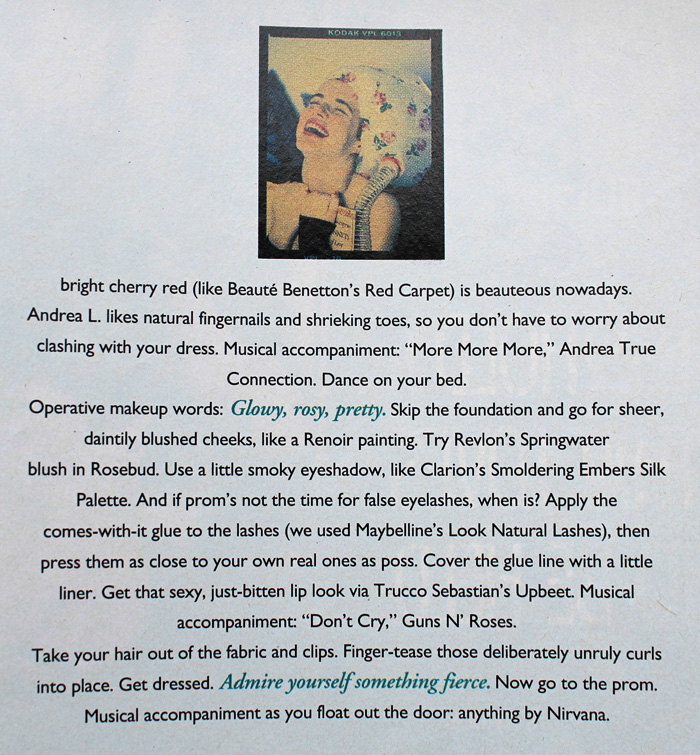
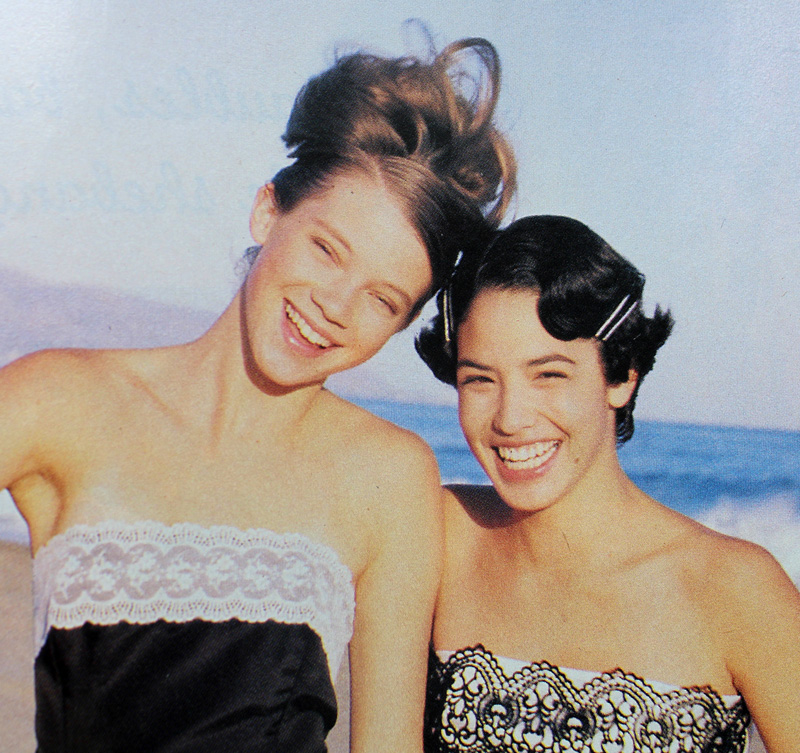
Sassy Magazine, March 1992. Hair – Colleen Creighton for Pierre Michel; Makeup – Lutz; Photography – Steven Miller
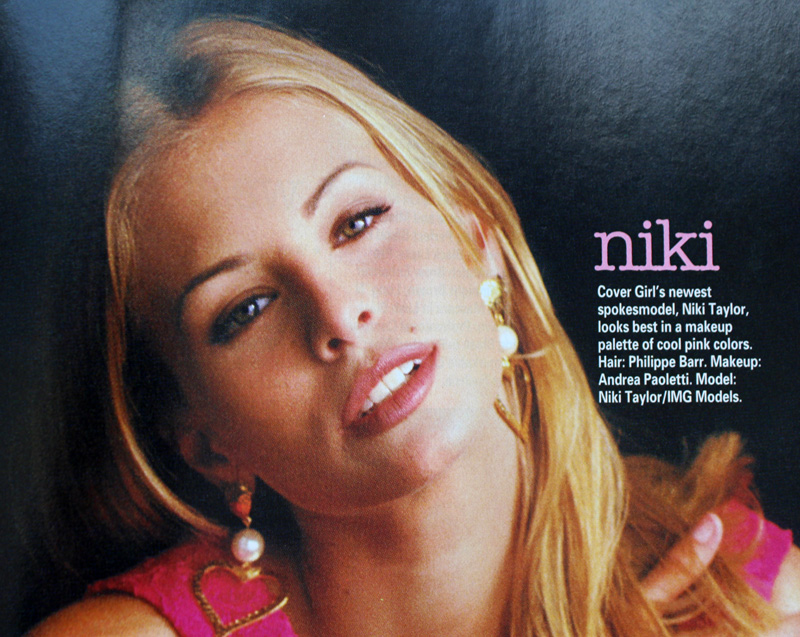
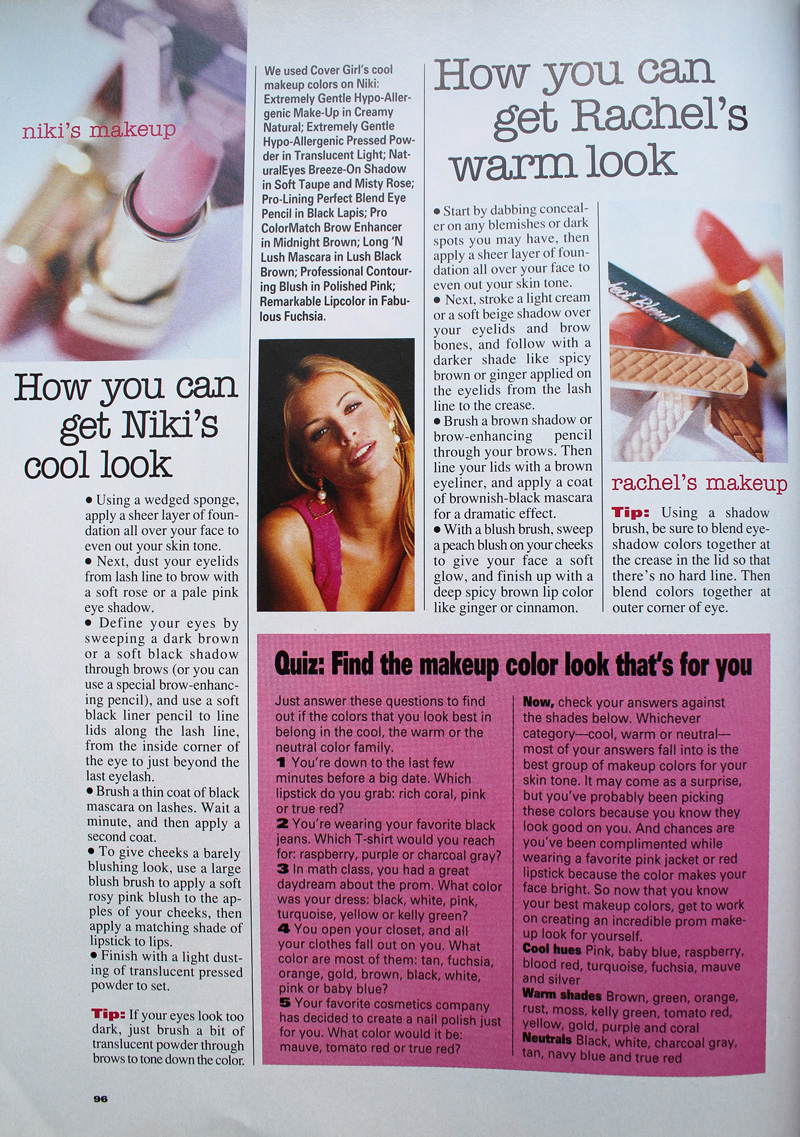
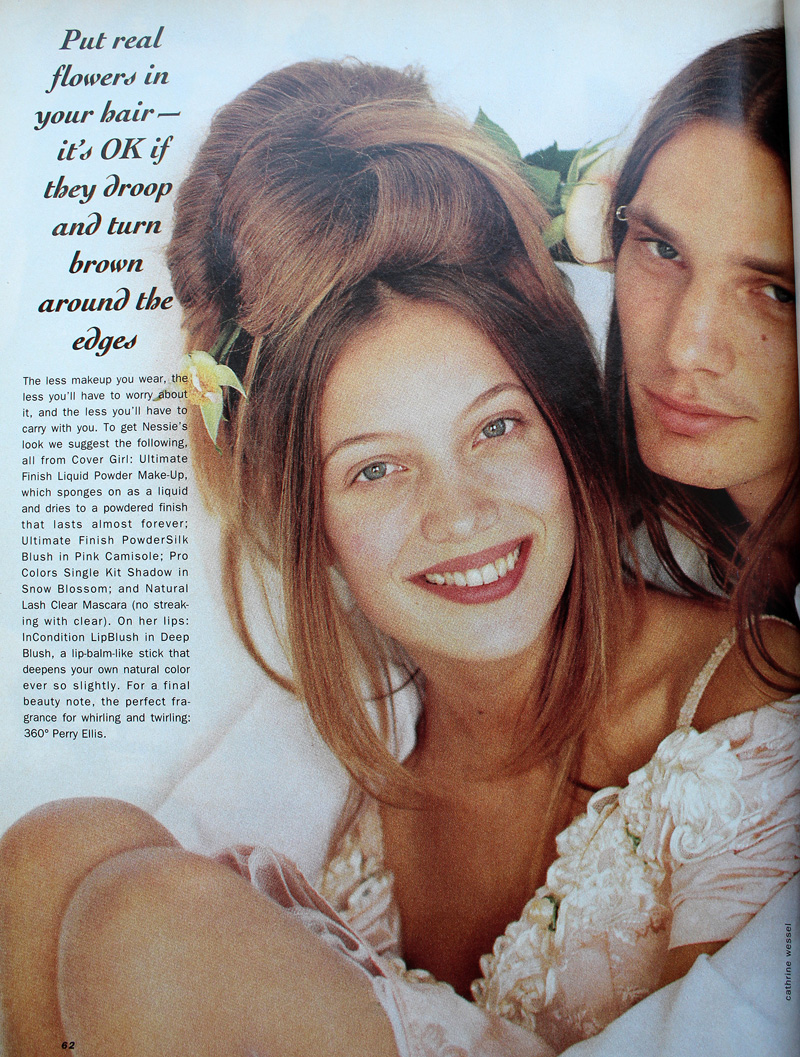
Sassy Magazine, March 1994. Hair – Daniel Howell for Oribe; Makeup – Regina Harris; Photography – Cathrine Wessel
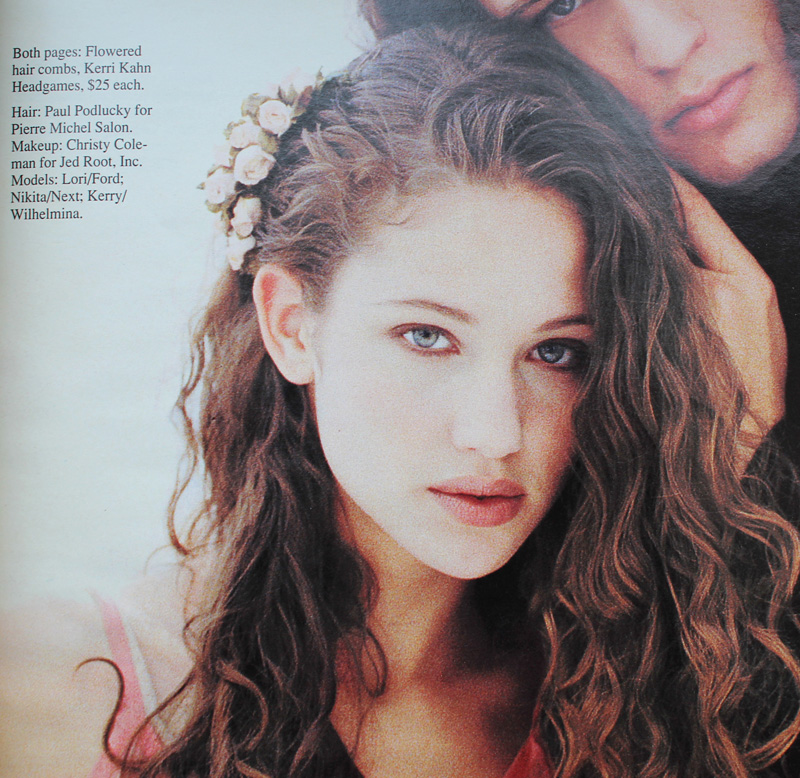
YM Magazine prom edition, 1994

YM Magazine prom edition, 1994. Hair – Gerald DeCock for Louis Licari Color Group; Makeup – Mara Schiavetti for Jean Owen
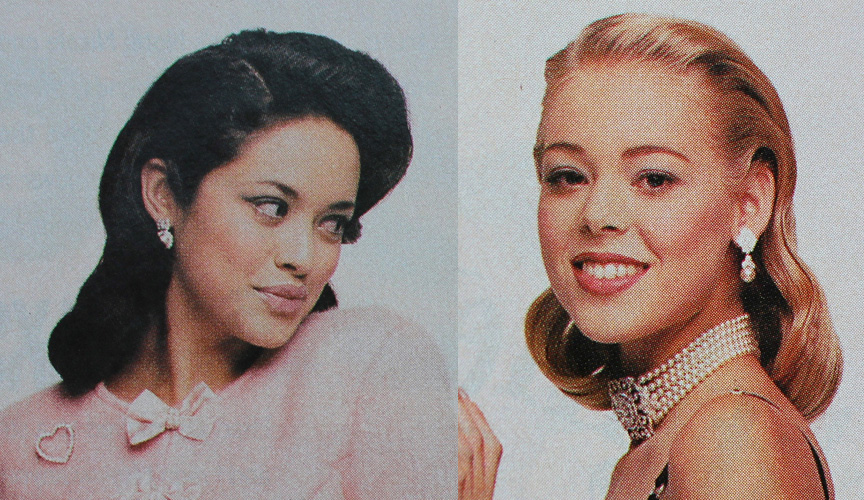
Sassy Magazine, March 1995. Hair – Diane Wiedenmann; Makeup – Sharon Gault for Cloutier

Sassy Magazine, March 1996
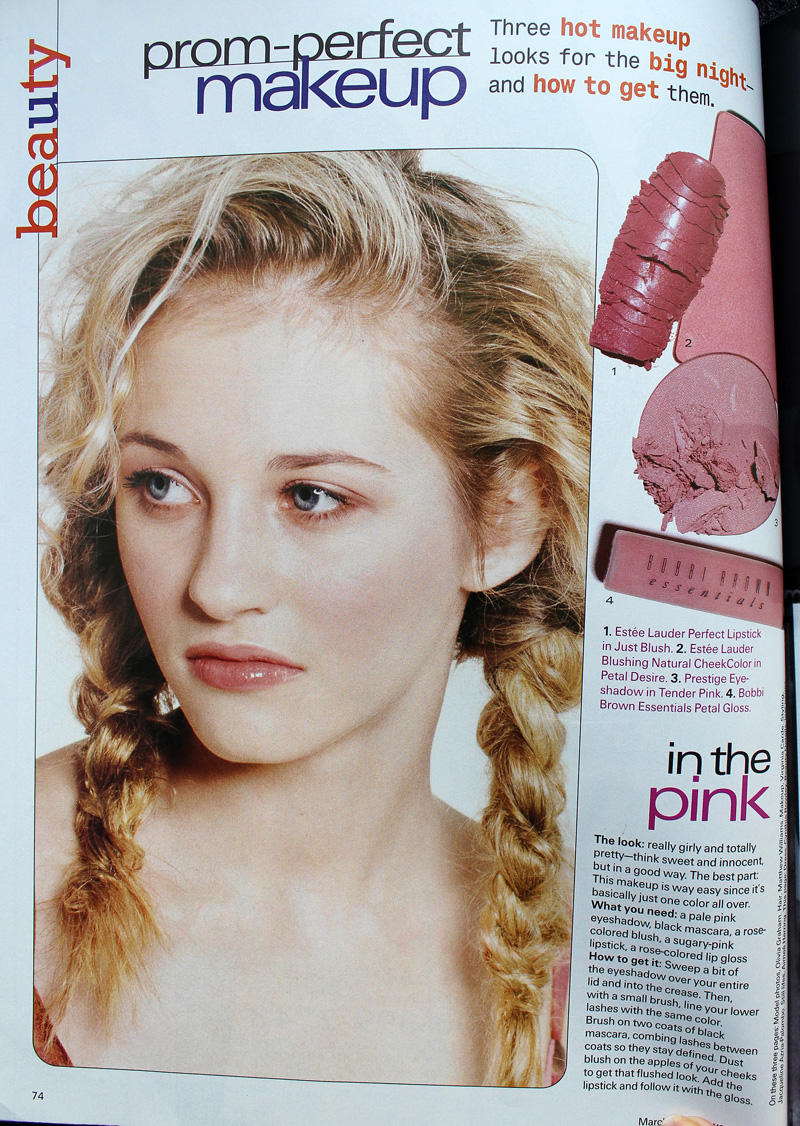
Seventeen Magazine, March 1997. Hair – Matthew Williams; Makeup – Virginia Carde; Still life photos – Aimeé Herring; Model photos – Olivia Graham
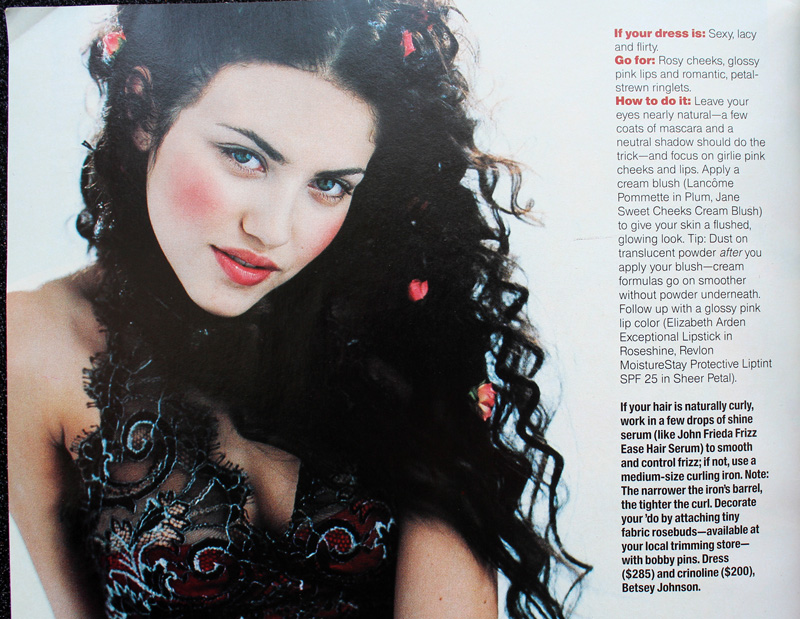
Seventeen Magazine, March 1999
Sixties-inspired makeup also seemed to be a popular pick in both the early and later parts of the decade.
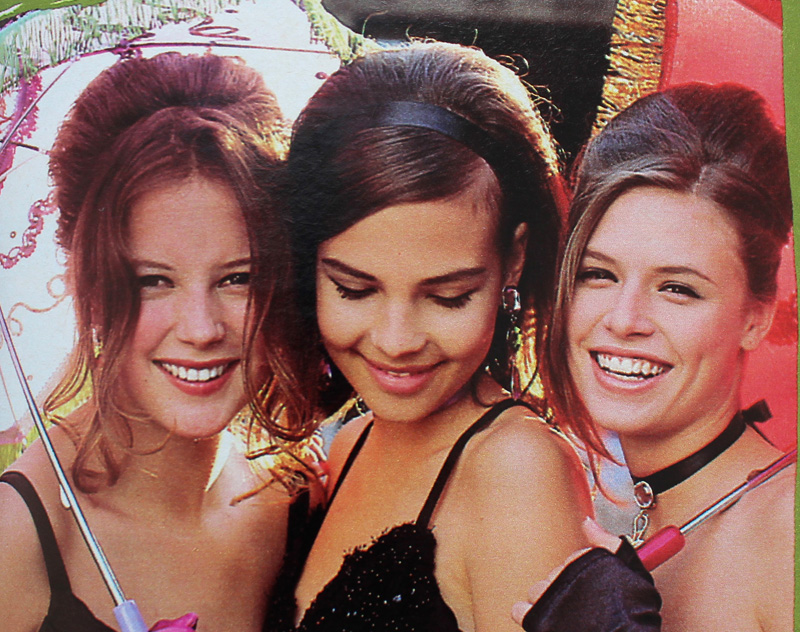
Seventeen Magazine, March 1991. Credits: Hair – Rodney Groves; Makeup – Timothy Metz; Photography – Tierney Gearon
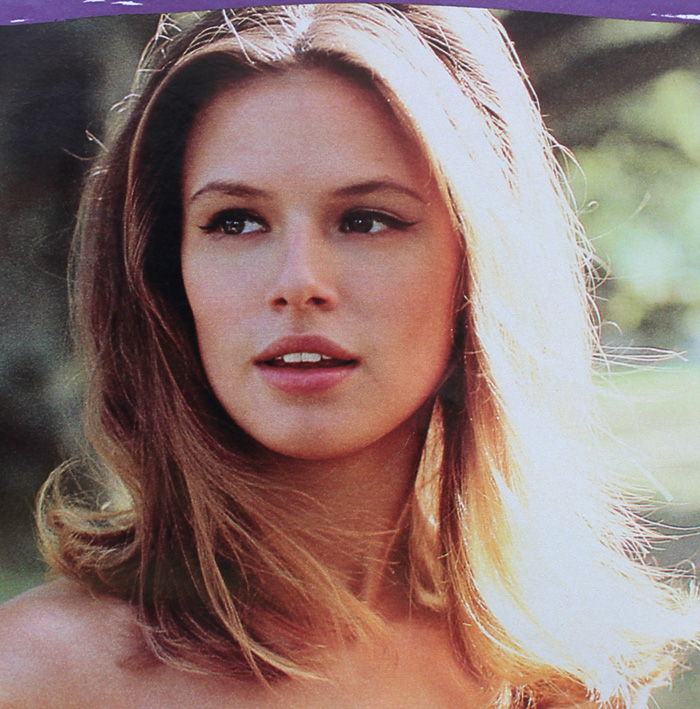
Seventeen Magazine, March 1991. Credits: Hair – Rodney Groves; Makeup – Timothy Metz; Photography – Tierney Gearon
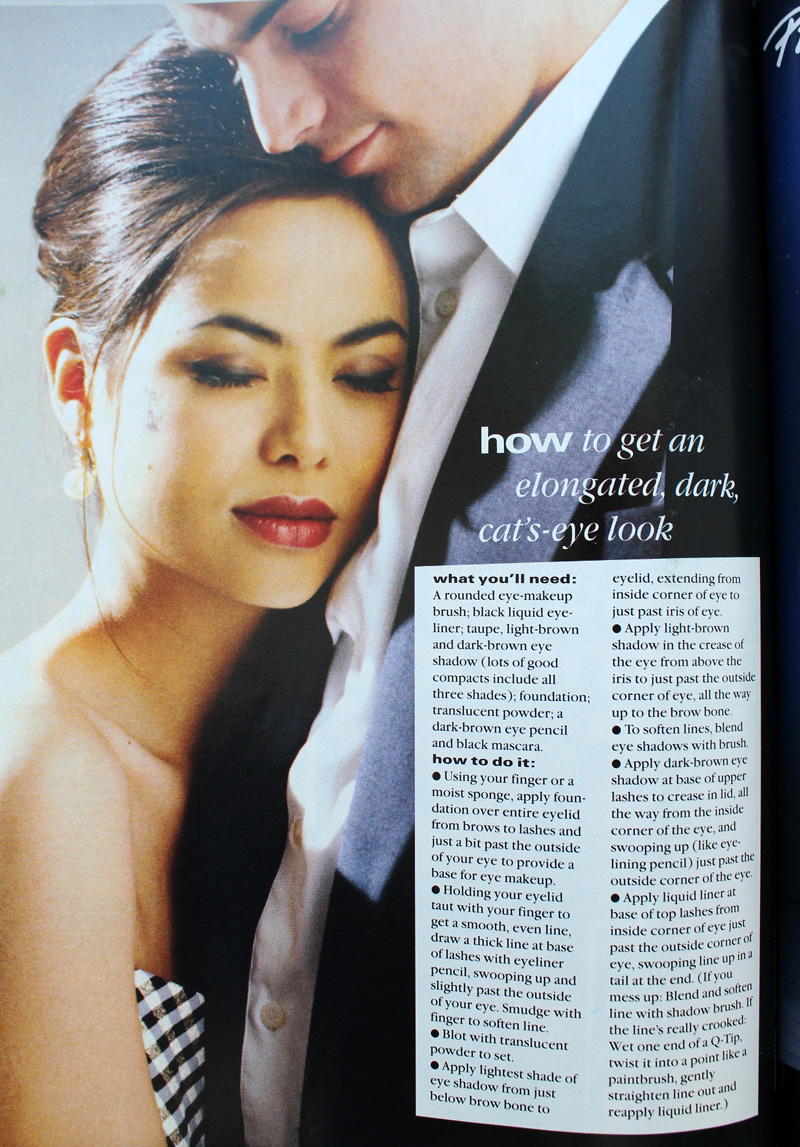
YM Magazine prom edition 1992
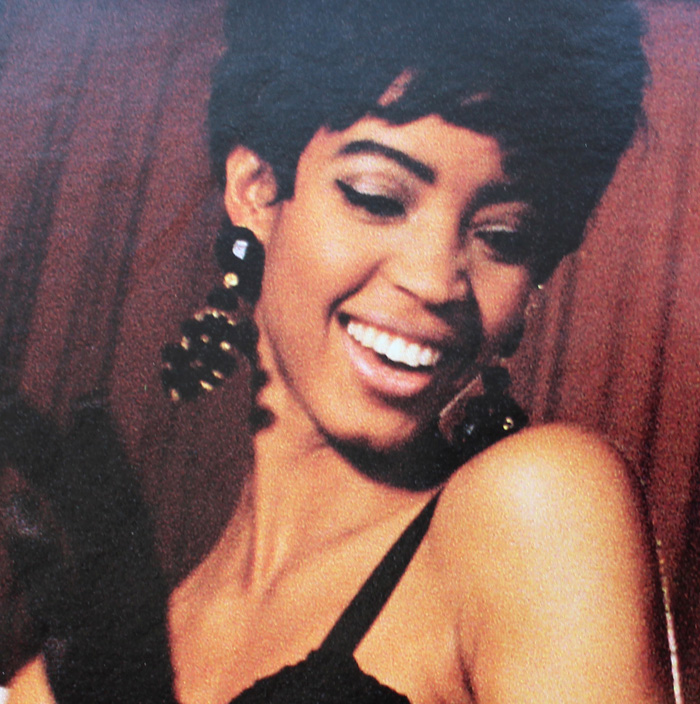
Seventeen Magazine, March 1991. Hair – Gabriel Saba for John Sahag Salon; Makeup – Jacqui Lefton; Photographer – Dewey Nicks
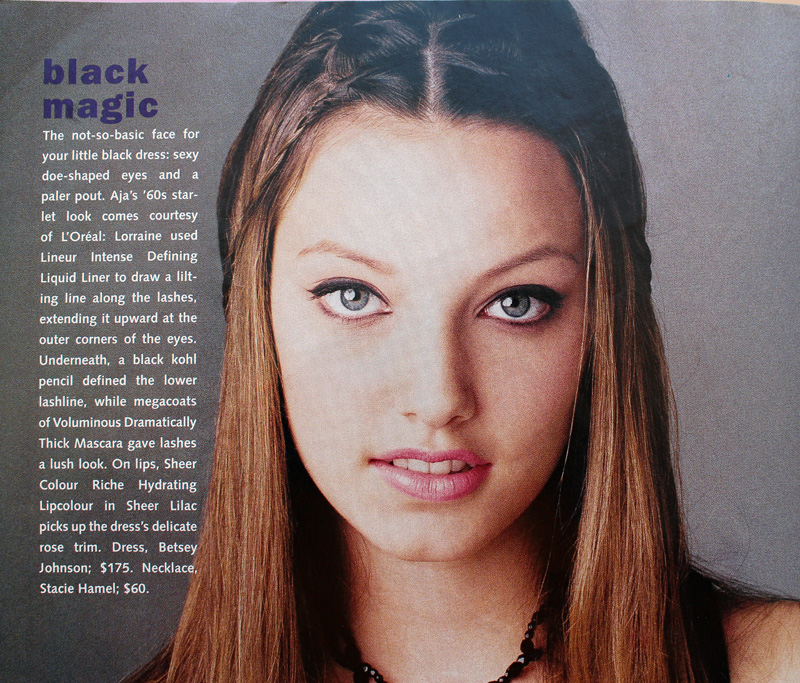
Seventeen Magazine, March 1994. Hair – Debbie Horgan; Makeup – Lorraine Leckie; Photography – Troy House
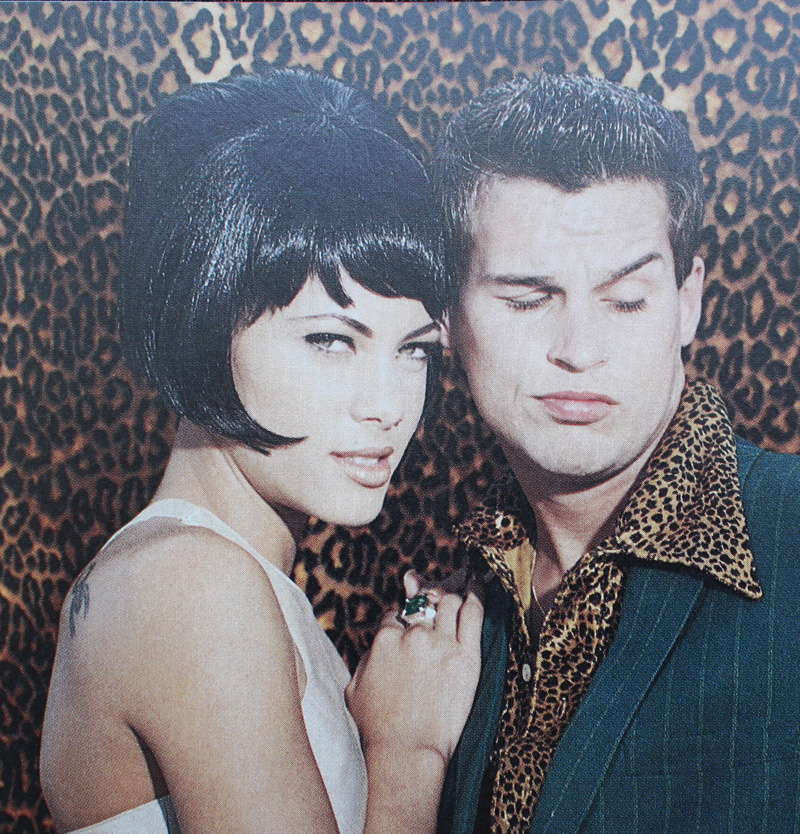
The most outrageous example is possibly from 1999’s Never Been Kissed. It’s like ’60s mod meets Evening Gown Barbie, Disco Barbie and Malibu Barbie, respectively (at least, according to the characters).

Never Been Kissed, 1999 with Kristin (Marley Shelton), Kirsten (Jessica Alba) and Gibby (Jordan Ladd). Makeup dept. head – Kimberly Greene; Makeup artists: Joni Powell and Lyssa Wittlin Baumert
Yours truly opted for the more subtle look. Yup, that’s the Curator at age 17, doing her best impression of Audrey Hepburn in Breakfast at Tiffany’s for her senior prom. I eschewed my usual dark plum lip in favor of Holly Golightly’s pale pink, and though you can’t make it out in this old picture, I also had some pretty serious feline eyeliner. (I actually am a disaster at winged liner; my sister’s friend did my makeup). Too bad I had to ruin my updo by adding the ever-present ’90s tendril…then again, the bangs were already atrocious. But I loved my makeup, gloves, jewelry (shout-out to Y necklaces!), and dress. I really regret getting rid of those last two.

Finally, grunge, goth and punk influences occasionally emerged from subculture status on a decade-wide basis.
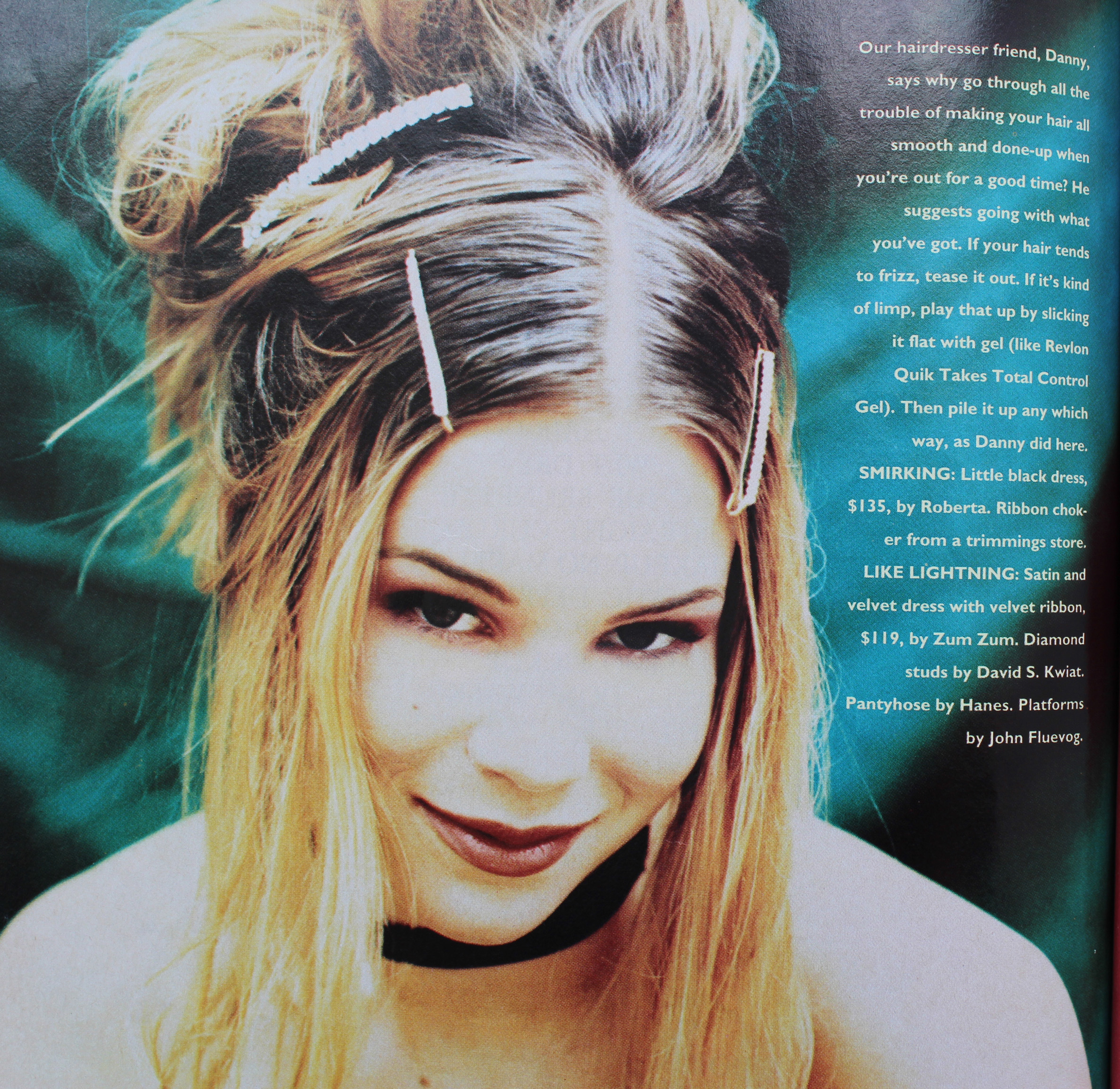
Sassy Magazine, March 1993. Hair – Daniel Howell. Makeup – Wei Lang. Photography – David Jensen

Seventeen Magazine, March 1997. Hair – Pasquale Ferrante; Makeup – Susan McCarthy for Shu Uemura; Photography – Grey Zisser
The models aren’t named in these next two photos but I’m almost positive I spy Alexis Bledel.
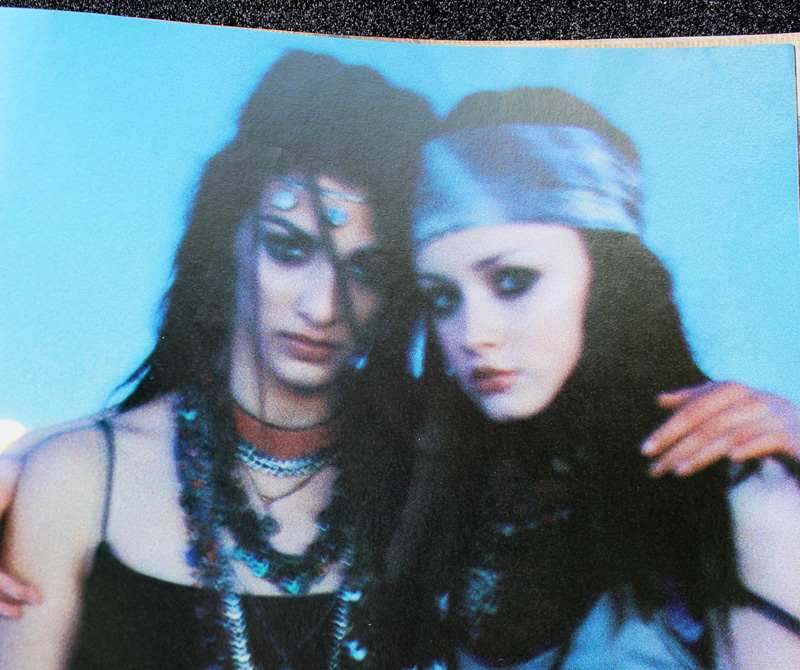
Seventeen Magazine, March 1998. Hair – Kevin Woon; Makeup – Kiyoshi; Photography – Marc Baptiste
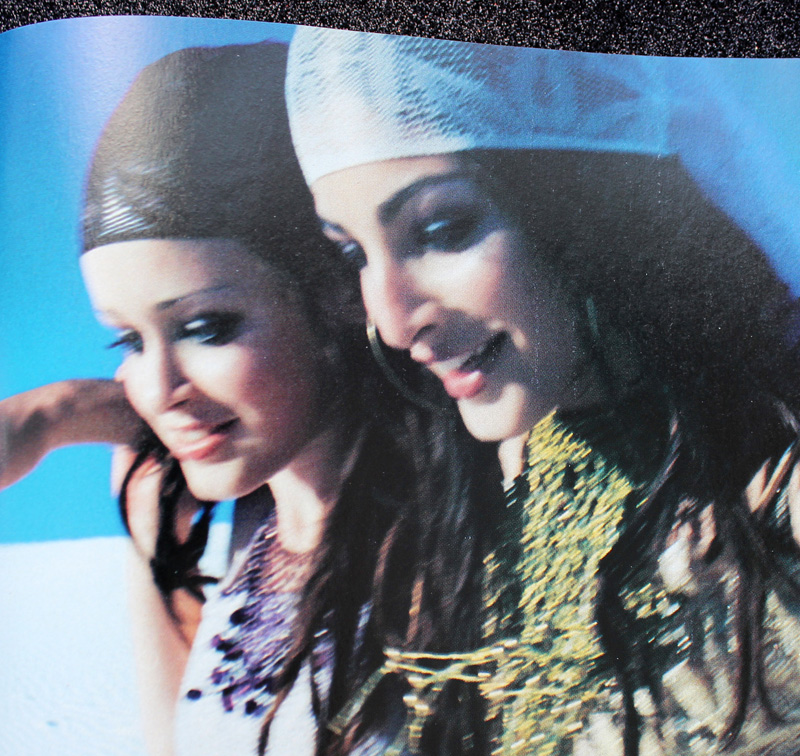
Seventeen Magazine, March 1998. Hair – Kevin Woon; Makeup – Kiyoshi; Photography – Marc Baptiste
There were a handful of exceptions to all the usual looks. In one feature from YM‘s 1993 prom edition, a red lip was paired with a pale gold shadow rather than brown or grey and it actually looks like some blush was applied. I would absolutely wear this today (minus the skinny brows, of course.)

Hair – Howard Barr for Celestine; Makeup – Wendy Osmundson for Cloutier; Model – Melissa Billingsly.
These next two looks had some appealing contrast between eyes and lips. While the eyebrow shapes are firmly ’90s, the mix of either cool purple or silver shadow with a satin-finish plum or pink lip falls outside the usual trends from the era.
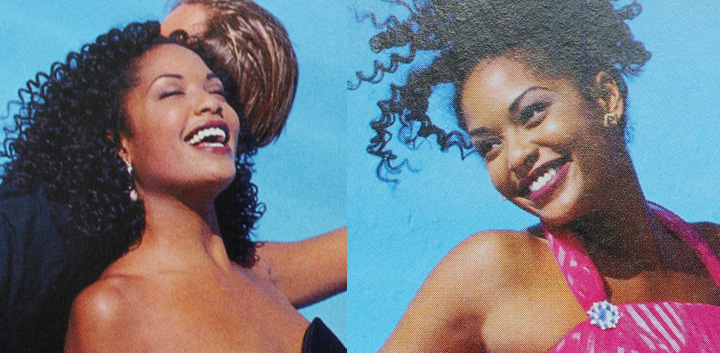
YM Magazine prom edition, 1993. Hair – Phillippe Barr for Salon Ziba; Makeup – Kelly Quan for Sarah Laird.
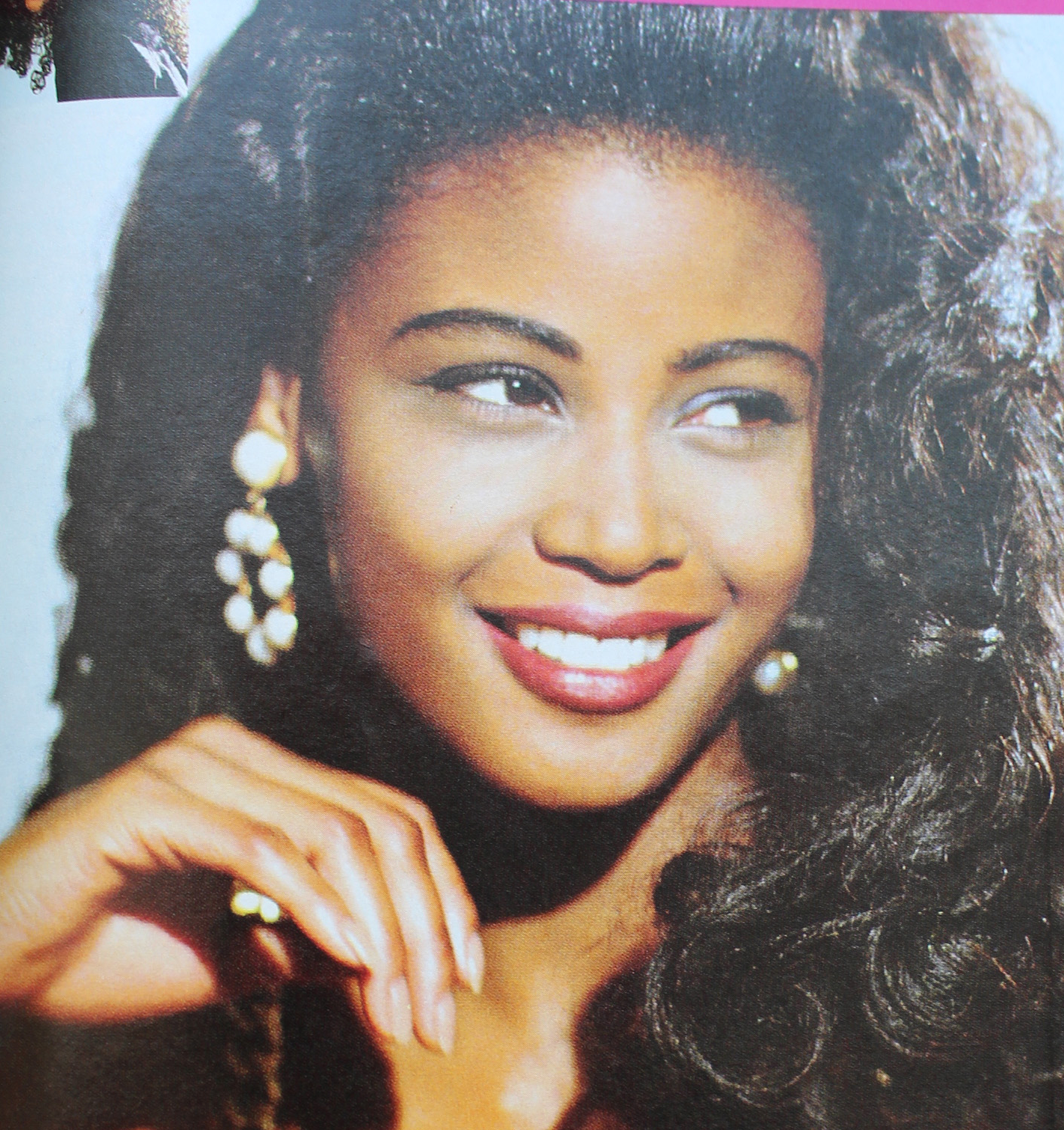
YM Magazine prom edition 1992. Hair – Brian Devine, Oribe at Elizabeth Arden; Makeup – Melissa Rogers
And here’s another monochromatic gold look, but it’s several years ahead of its time.
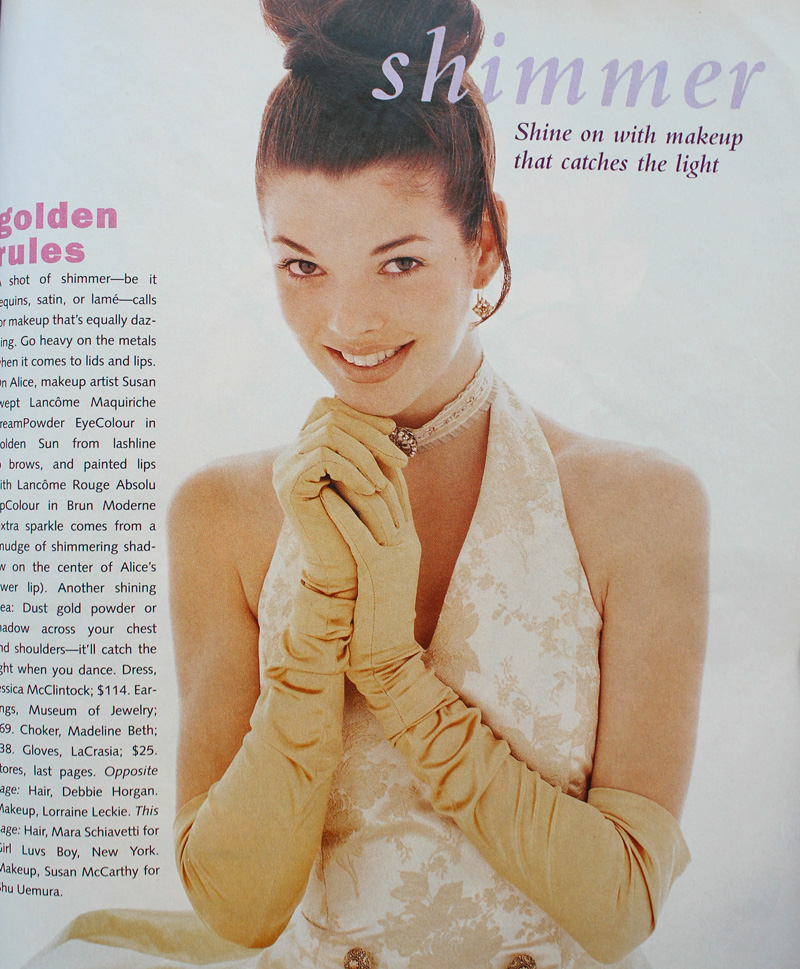
Seventeen Magazine, March 1994
But there weren’t really many outliers. Overall, prom makeup in the ’90s seemed very much a microcosm of the larger trends of the decade. It was a little disappointing not to uncover any totally atypical looks (although I do think the late ’90s was way more fun than the start of the decade). But I’m guessing the big magazines and movie studios/TV shows weren’t going to push much unconventional prom makeup or feature anyone who wore it, and those who would opt for more daring looks on a regular basis probably weren’t going to prom. Fortunately, mainstream media has somewhat caught on to a new aesthetic. The styles are very safe in most magazine covers and online content. The looks are nice and definitely updated from the ’90s, but they are, shall we say, basic, or mimicking “Instagram” style makeup. However, a closer look suggests there is experimental, Euphoria-type makeup being recommended, such as the incorporation of embellishments (flowers, gems, etc.), graphic liner in a bright color, or creative use of glitter. For example, compare several of Seventeen‘s recent prom covers with their online recommendations, or the fairly unremarkable cover look on Teen Vogue‘s 2014 prom issue with the far more interesting editorial inside. (Diversity in terms of race and body shape/size still needs work.)
I was very relieved to see these looks, as I was horrified at the possibility of Gen Z’ers receiving the same advice that me and my fellow Gen X’ers did, i.e., to play it safe. In my day prom was akin to one’s wedding in terms of makeup (which is another whole disturbing can of worms that I don’t want to open right now.) The most common tips for both occasions were to play up one feature only, stay away from using multiple colors, and don’t deviate much from your everyday look, along with a bunch of tricks to help one’s makeup last longer. Ho-hum.
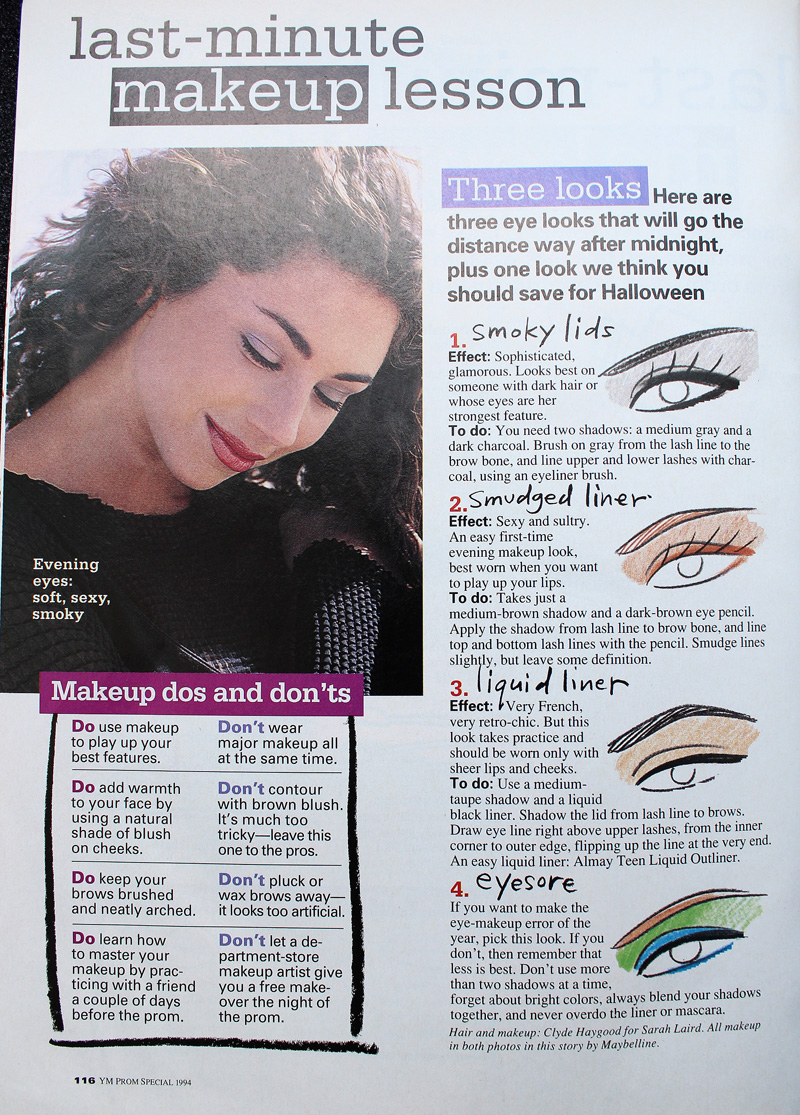
Not surprised by Bobbi advocating for safe makeup.
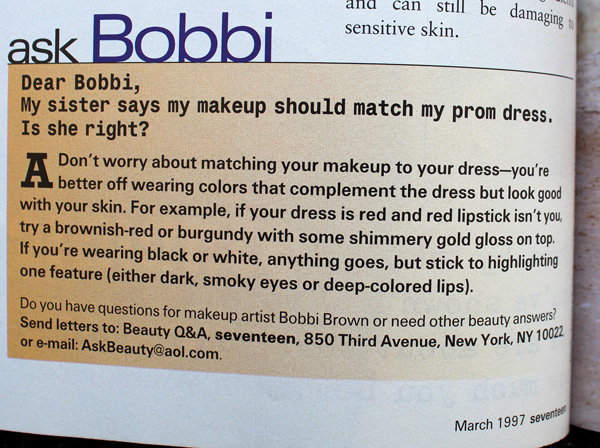
If simple and natural is your style, or you don’t want to try anything too wild for a big occasion, great! But I’d like it if makeup that actually takes risks were as normalized as looks featuring minimal makeup.
While this hasn’t been the most insightful post, a glimpse of ’90s prom makeup serves as a good refresher on the decade and helps give more context to the trends. Plus as a print junkie, it was insanely fun to flip through old magazines. (The movies did not hold up well..although honestly even at the time they were fairly problematic.) It kind of makes me want to do a whole book or exhibition on prom makeup from all decades. 😉
Any favorite looks here? Did you attend any proms or formals in high school and if so, do you remember your makeup or have any photos you’d be willing to share?
No posts for this week and no Curator’s Corner today, but I’m pleased to announce that Ada Calhoun, one of the authors behind the awesome 90swoman.com blog, asked me to write a piece on 90s womanhood!! I was so honored. Naturally my thoughts went to makeup and 90s beauty trends. And also naturally, I was extremely long-winded so the piece was edited ever so slightly so as not to bore readers. However, I have no issue with boring my own readers (all 2 of them, ha), so here it is in its entirety. Enjoy! And do check out 90swoman.com, even if you’re not of that generation – it’s truly a fascinating look at the era. 🙂 Thanks again, Ada!
Matte brown lipstick. Heroin chic. White eye shadow. The grunge look. These were the major beauty trends of the 90s. And they’ve been earning the attention of the fashion and beauty world in the past year or so. In January 2010 Selfridges staged an in-store exhibition devoted to the 90s, complete with a vintage M.A.C. Cosmetics face chart showcasing their (at the time) wildly popular brown lip liner named, appropriately enough, Twig. Fashion and beauty bloggers have also been covering the revival of the decade’s trends. “Messy plaids, patchwork and the overall look of 90’s grunge is back for Fall 2010, and we aren’t just talking about the fashion. The beauty industry is taking its cue from the Courtney Love days of dark, red lipstick paired with overdone, smoky eye make-up…A disheveled plaid tee layered under a floral dress and dirty boots are the perfect balance with a dramatic ‘I don’t care’ make-up look,” wrote Jessica Ciarla at The Fashion Spot. Last summer beauty blog Lovelyish provided a nostalgic look at 90s makeup trends. This year, fashion blog Refinery29 reports that the “sleeper hit” of summer 2011 is 90s grunge lip color: “Even though summer is currently awash in happy, vivid corals and pinks, there’s another lip trend we’ve been tracking, too: A modern version of grunge-inspired lips. Mixing deep magenta-red with a little shimmer, they’re like the love child of a ’90s era Drew Barrymore and Married with Children‘s Kelly Bundy… pair your tribute-to-the-nineties lip with extra dark brows and matte skin. So angst-y!” Finally, retailer Urban Outfitters named Cher from 1995’s Clueless their latest beauty icon.
Fashion trends, and by extension, beauty trends, are cyclical – usually about 20 years after the initial phenomenon began, it becomes in vogue once again and is slightly updated. So it’s not surprising that the 90s are making a comeback now.
But the point I want to make isn’t that the 90s are back fashion and makeup-wise. Rather, I want to take a look at the transformation the beauty industry underwent in the 90s as a direct response to the new notions women had about makeup. In 1995, the L.A. Times quoted a beauty newsletter editor as saying, “The creativity the department stores had 10 years ago doesn’t exist today…the top five brands control 75% of the makeup business.” Something had to give to meet the beauty needs of the 90s woman, and it did.
Between the influence of “lipstick feminism”*, Naomi Wolf’s The Beauty Myth, Riot Grrrl (and “girl power”, its co-opted, commercialized, mainstream offshoot made popular by the Spice Girls), and the smeared red lipstick of grunge poster child Courtney Love, more and more 90s women began wearing makeup not with the simplistic goal of looking pretty, but rather as a means of self-expression and empowerment. They also didn’t want to feel as though they were being brainwashed by cosmetic companies telling them that they wouldn’t be beautiful without makeup – wearing it had to be their decision alone, and they would wear it (or not) on their own terms. This outlook represented a huge shift in thinking about cosmetics, and beauty and business gurus pounced on it.
In 1994 makeup artist Jeannine Lobell created a makeup line called Stila. The name coming from the Italian word “stilare”, which means “to pen”, Lobell believed every woman’s makeup should be as unique as her signature. The cardboard containers (this environmentally-friendly packaging was a breakthrough at the time) also displayed quotes from famous women that could be seen as empowering: Elizabeth Cady Stanton’s “The best protection any woman can have is courage,” and “Failure is impossible” by Susan B. Anthony are just a few of the quotes that made an appearance on Stila’s eye shadows. These marketing strategies encouraged the idea that women could let their individuality shine through their makeup, and that it could even make them feel powerful.
1995 and 1996 saw the introduction of “alternative” makeup lines Hard Candy and Urban Decay, respectively. Both got their start by introducing non-traditional nail polish colors that the founders first mixed themselves – Sky, a pastel blue, in the case of Hard Candy, and a purple color from Urban Decay. And both were revolutionizing the beauty industry and filling in the gaps left by mainstream cosmetic companies by offering non-traditional hues. From the Urban Decay website: “Heaven forbid you wanted purple or green nails, because you’d either have to whip out a marker, or risk life and limb with that back alley drugstore junk…The first magazine ad [for Urban Decay] queried ‘Does Pink Make You Puke?,’ fueling the revolution as cosmetics industry executives scrambled to keep up.”
A 1998 New York Times profile of Hard Candy founder Dineh Mohajer, states that she was a leader in providing the modern teenage girl with the daring makeup she wanted to use to express herself. “Ms. Mohajer’s timing couldn’t have been better: young women were ready for hard-edged, ‘ugly’ colors, which were a departure from the powdery, harmless pinks that once accompanied every American girl’s journey to womanhood. Suddenly, blue lips, blue hair and blue fingernails became a statement about independence — even if independence might make you look as if you were suffering from frostbite.” Still, in the article Mohajer insists that ”I didn’t make that first batch of blue nail polish so I could stand up to men or be outrageous…or so I could make some sort of stand for women.” She continues: “[what] it’s really about is self-esteem, women being able to do whatever they want and look stylish and attractive and cute at the same time.” Mohajer, who was all of 22 when she founded Hard Candy, clearly represented the new way in which women were viewing makeup.
The decade culminated in the 1999 release of celebrity makeup artist Kevyn Aucoin’s iconic book Making Faces. The book offered details of makeovers performed on “real” women, and provided step-by-step instructions to create a myriad of looks. Women could essentially try on personalities like “The Diva” or “The Siren” through makeup. Aucoin writes in the introduction, “…it is my hope that you will find yourself, or rather, your selves inside.” His book was illustrative of the sweeping change that took hold in both the general population’s notion of cosmetics and the beauty industry.
Where does all of this leave us now? I’m of the opinion that if you asked teenagers and women today, most would say they don’t wear makeup for anyone but themselves. Personally I wear it because it makes me happy and because I think it’s fun to play with color, not because I feel as though I have put on my “face” before going out in public. While I can’t know for sure what other women think, I have a feeling most of my generation and younger generations share this perspective. That is one of the indisputable legacies of the 90s.
So, girls and women of today, bear in mind that your perception of cosmetics is in some way descended from ground-breaking beauty philosophies that were set in motion some 20 years ago. The notions that makeup can be a creative outlet and a way to express your individuality were forged back then. And if you’re a true 90s woman, relish the current comeback of makeup trends from your decade…everything except the matte brown lipstick.
*The debate between lipstick feminists and second-wave feminists is far too broad to discuss in this post. I’m leaving out the argument as to whether women should or shouldn’t be participating in beauty rituals; I’m only mentioning lipstick feminism as one of the many reasons for the change in women’s perception of wearing makeup in the 90s.
 I'm always so grateful when someone agrees to an interview with the Museum, and the one I'm featuring today is very special! You might remember the AstroLips lipstick line that was mentioned in the Museum's history of zodiac-themed makeup and how I was puzzled over not being able to find any information about it or its creator, makeup artist Scotty Ferrell. Well, as luck would have it, Scotty found the Museum's article and introduced himself and offered more information on the line. Naturally I wanted to hear as much as possible about it, along with Scotty himself! He kindly granted me an interview. Please read on to discover his work, his experience working with some of the biggest brands in the '90s and early 2000s, and his latest venture: an (actually useful!) beauty app.
I'm always so grateful when someone agrees to an interview with the Museum, and the one I'm featuring today is very special! You might remember the AstroLips lipstick line that was mentioned in the Museum's history of zodiac-themed makeup and how I was puzzled over not being able to find any information about it or its creator, makeup artist Scotty Ferrell. Well, as luck would have it, Scotty found the Museum's article and introduced himself and offered more information on the line. Naturally I wanted to hear as much as possible about it, along with Scotty himself! He kindly granted me an interview. Please read on to discover his work, his experience working with some of the biggest brands in the '90s and early 2000s, and his latest venture: an (actually useful!) beauty app.












































































